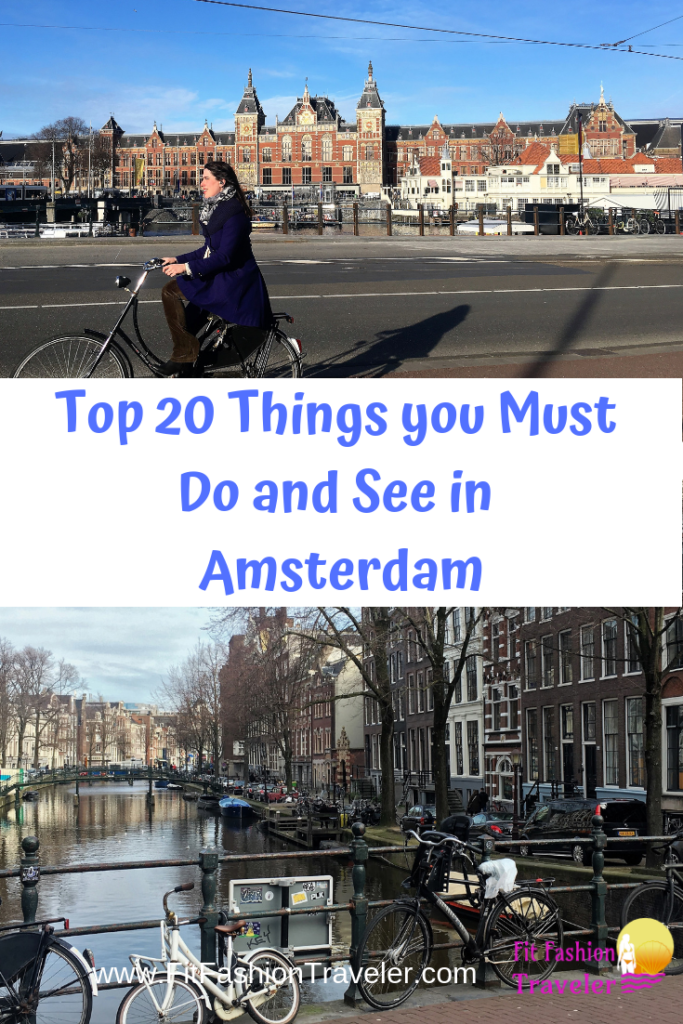
by Kelly | Feb 23, 2018 | Bermuda, North America, Travel
Last October I joined some of my family members for a 7-day, 10-person family and friends cruise! My aunt, uncle, cousin and her family, and three family friends flew out to Boston from Chicago to embark on the Norwegian Cruise Line ship the Norwegian Dawn with me on a cruise to Bermuda. Being an only child, most of my family vacations growing up consisted of traveling with just one or both of my parents, so having such a big group was a much different experience for me, and one that I certainly enjoyed!
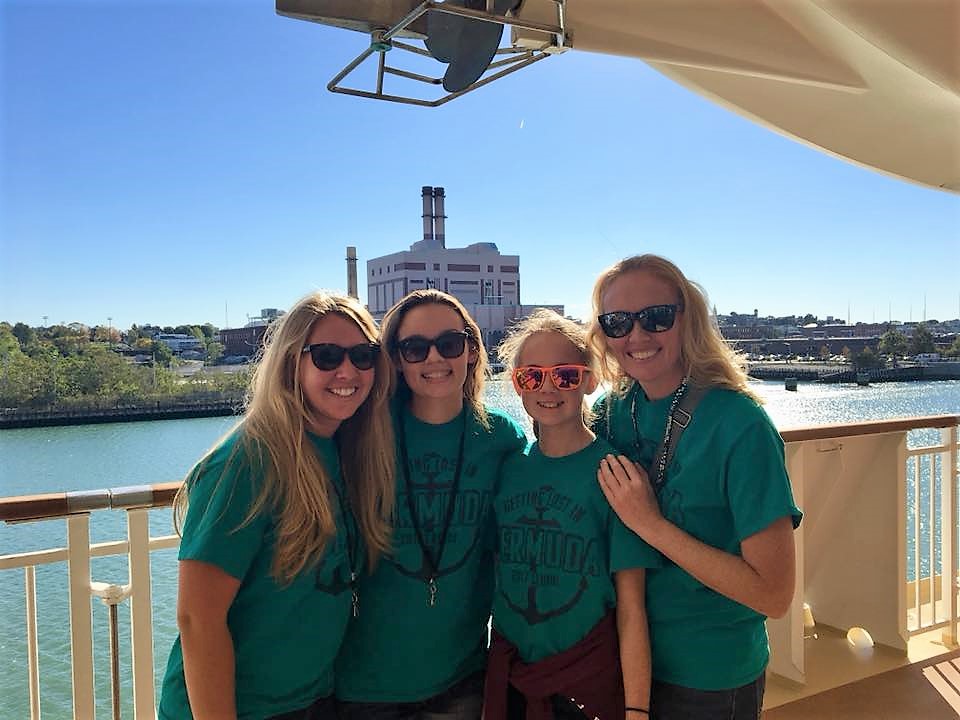
Leaving port, wearing our matching Bermuda shirts: key for locating each other on the first day!
This post will focus on adventures and advice on board the ship that can transfer to almost any cruise, especially those on the Norwegian Dawn. In my next post I’ll provide a one-day itinerary of Bermuda and some tips and tricks for the island.
On Board the Ship
Our cruise consisted of three full days at sea, one on the way to Bermuda and two on the way back. On the outbound trip the weather was warm and sunny so we were able to spend most of the day sitting by the pool and enjoying our unlimited drink packages, which are totally worth it! However, the return to Boston was marked by stormy skies and rough seas, thus requiring us to stay inside and partake in many of the on-board activities offered by the entertainment crew. We still made the most of it and had an awesome time on board.

Here are some of my top recommendations for cruising on the Norwegian Dawn.
Food and Drink
If you have options for free packages with your cruise, the all-inclusive drinks and specialty dinners are absolutely worth it. The bar tenders will make any drink you want (don’t like the pre-made margarita mix? Ask for a cocktail made with just tequila, triple sec, lime juice, and simple syrup) and the food in the specialty restaurants is unique and delightful. The best part about the all-inclusive packages is that you can remove the stress of thinking about the prices of these things from your vacation!
For those of you concerned about how to stay healthy with all-inclusive food and drinks, I’ll share a secret with you: one of the keys to eating in an all-inclusive environment is recognizing that it is not “all-you-can-eat” but instead a break from worrying about price. At an a la carte restaurant perhaps ordering two fried appetizers would be cheaper than the grilled salmon and your favorite vegetable, but in an all-inclusive situation you can go for the salmon with no worries. The same goes for the drinks: if you want to try the rum swizzle and then decide it’s not for you after two sips, you can ditch it without thinking about the $14 you may have just paid for it in order to spend your calories on something you will enjoy.
On the cruise, my travel companions and I appreciated having the all-inclusive option because it allowed us to enjoy a welcome cocktail when we first boarded, drink any wine we desired with dinner, and try a variety of mojitos from the mojito bar on the top deck. Keep in mind when ordering wine that the all-inclusive drink package will give you unlimited glasses, but you will be charged for a bottle! Instead of ordering a bottle of wine for dinner, we would each order a glass of the same kind of wine, and it was completely free. We also dined at two specialty restaurants, the Bamboo Asian Restaurant (which has free options) and Cagney’s Steakhouse, both of which I would highly recommend. Be warned that portion sizes in the dining rooms are smaller than on land: don’t make the mistake I did the first day at lunch thinking I could subsist on just a soup and appetizer salad!

Checking out the unfortunately small sushi appetizer and debating eating it with two knives since we were not provided chopsticks
Attire
One of the first questions I always ask whenever I go anywhere is “what should I wear?” For the most part on the cruise, typical vacation or warm-weather attire will suit you well. If you plan to dress up, be sure that you wear shoes that can withstand walking on a rocking boat (aka no stilettos). There are no formal nights on Norwegian Cruise Lines, but you will not be out of place if you decide to throw on a cute dress or a collared shirt. In fact, in order to dine in the Venetian Dining Room at dinner time you must be wearing either pants or a dress/skirt: you will be turned away if you are wearing shorts, as our party learned the hard way. There are many other dining options so you will not be out of luck if all you have are shorts, but keep this in mind and pack at least one nice outfit if you want to keep your options open.

Our typical evening attire
The other special attire recommendation is to bring something white for the White Out party, hosted on the top deck the night you leave port. Usually the pool deck is relatively quiet at night, but for the White Out party the ship’s Cruise Director brings out live music and the dancing entertainment crew for a huge black light party! You can still participate if you are wearing colored-clothing, but most people will be wearing white, and it’s fun to get in on the festivities with them.
Activities
I’m sure thinking of cruise activities you immediately pictured yourself sitting by the pool all day while at sea, maybe reading a book, listening to music, and occasionally dipping into the water. Almost everyone else reading this also pictured the same thing, so you’ll either have to arrive poolside early to stake your territory or pick different activities to entertain yourself while at sea. Even if you do claim a coveted poolside chair, your space in the water will be limited.

One alternative is to spend some time in the gym or the spa. The gym on the Norwegian Dawn was incredible! They offered classes in their studios (some which cost money), and had a full set of cardio and strength machines as well as free weights. I made a commitment to go to the gym each day we were at sea and do either a HIIT, Cardio Dance, or Cardio Kickboxing workout. Two of the three days I used the studio because it was unoccupied and also had the most incredible views of the sea in its floor-to-ceiling, wall-to-wall windows. If you are able to make this type of commitment, as well as commit to taking the stairs instead of the elevator (saving time as well as calories) and practice the stress-free version of all-inclusive food and drink options, you could have an awesome vacation and come back a couple pounds lighter like I did! One thing to keep in mind if you do go to the gym is that the ship will be rocking, so this may not be the best time to practice your static squat.

One of two gorgeous studios in the gym
Another activity option is to check out the daily schedule of activities around the ship and pick a couple that appeal to you. Because my travel group was so large, we were able to attend the activities we wanted, usually with two or three others from our group, and then reconvene for dinner in the evening. I was drawn to some of the travel trivia games, such as “Flags of the World” visual trivia, my aunt attended all of the arts and crafts options, and my niece was excited to help with the towel-folding demonstration.
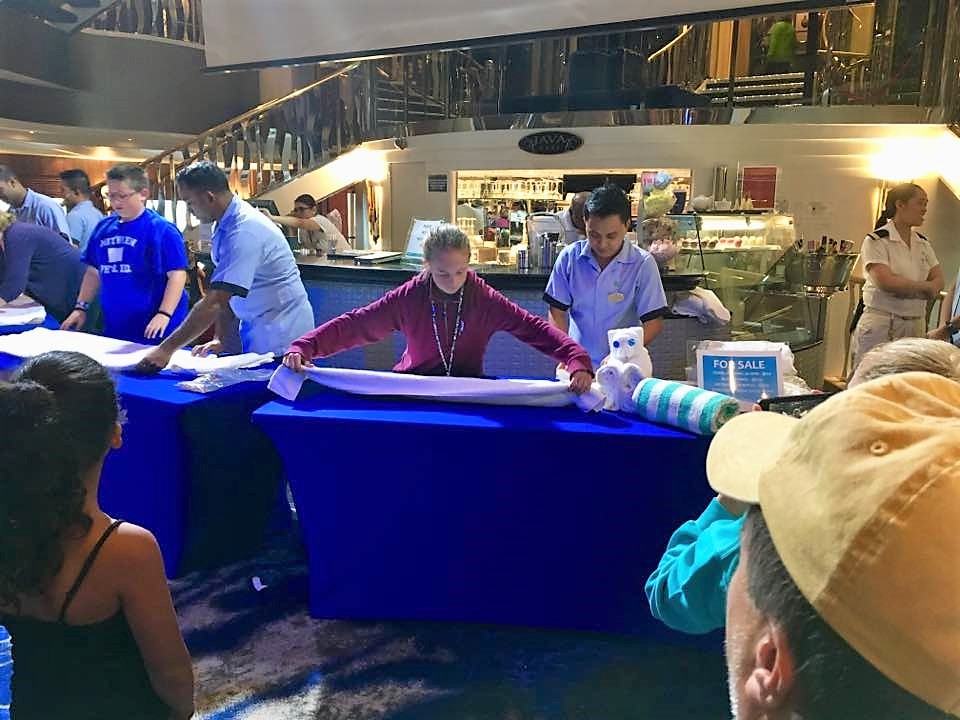
The evening entertainment is also plentiful, and you can’t go wrong with whatever you choose. We enjoyed the performances by the entertainment crew, comedy shows by Chicago’s Second City cast, and demonstrations by the resident illusionist. I was particularly excited for the Sunday night entertainment because the week I was on the cruise was the week the American football team the New England Patriots were playing a Super Bowl rematch against the Atlantic Falcons, and because the cruise left out of Boston, the game was being shown in the Atrium on a jumbo screen! A few of the ship entertainers hosted a pre-game tailgate in the Atrium and the Irish pub overlooking the Atrium, then all the Patriots fans on board were able to watch the game and cheer together as we were once again victorious over Atlanta. I even made friends with other young adults from Boston once my Midwestern family became bored with the crushing blow the Patriots were serving the Falcons. My one regret from that night was not realizing that everyone else would be donning their Patriots apparel: I hadn’t even thought to bring it, as I hadn’t realized what a big deal the game would be while on vacation.

Cruise Advice
My #1 recommendation is to download the NCL app to your smartphone before you even get to the ship. Once you’re on the ship, pay the $10 per person for the on-board communications in the app. It was so much easier communicating plans among the group using the app communications rather than our original plan of writing notes to slide under each others’ doors and hope the other people saw the note. The app will also give you the schedule of activities for each day of your trip, restaurant hours, and any other logistic information you need. If you decide to purchase WiFi, you will do this through the app as well.
My second recommendation is to forego the WiFi and enjoy your disconnected vacation. If you need to purchase WiFi, purchase the cheapest plan, turn it on to quickly check your email, send a text, and post to Facebook, then go back to the website on which you turned it on and turn it off again. This will allow you to conserve your purchase and hopefully stick to the lowest paid plan, which was $25 when I went, for the entire trip.
Another consideration is to try to select on-board activities that are not located in Gatsby’s Champagne Bar. I was disappointed with how the Champagne Bar was connected with the cigar lounge on board. Even though the smoking area was completely enclosed, the smell still eked out after a while. My 10-year-old niece and I enjoyed a few activities in Gatsby’s, like making flower crafts and learning Filipino phrases, but we couldn’t stick around too long because of how awful the smell became.
Finally, my most fun advice: every day when you return from the island, put your bathing suits on, grab a drink, and head right for the hot tubs. There were almost no people there at this time because everyone else was getting ready for dinner, so we had the hot tubs to ourselves to relax and enjoy before beginning our evenings. It was the perfect end to each day, and something not to be missed. Cheers!

Love this post? Save it on Pinterest for later!
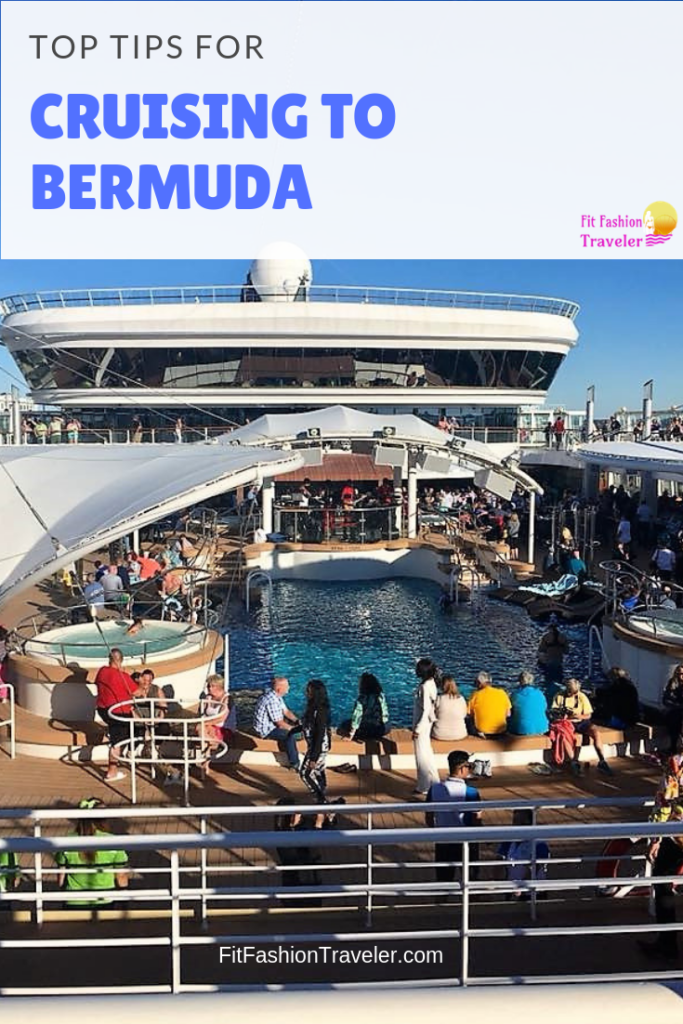
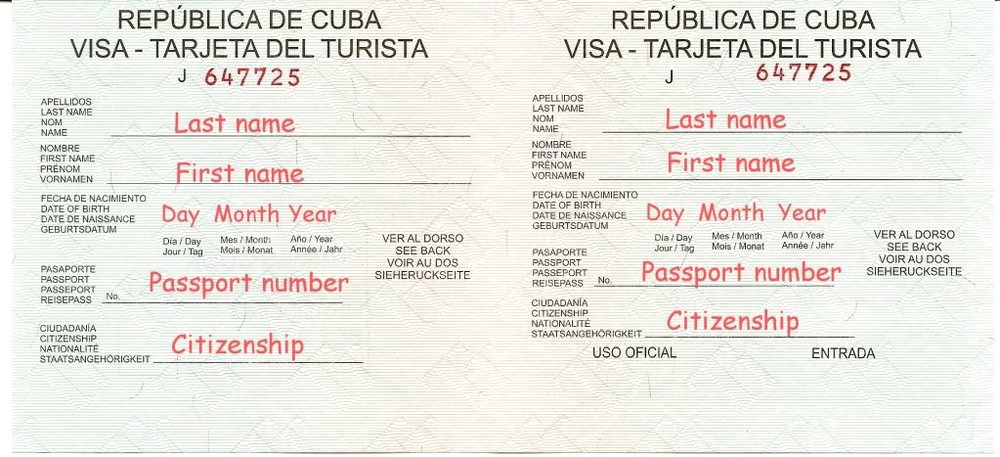
by Kelly | Apr 3, 2018 | Caribbean, Cuba, Travel, Travel Advice
(N.B. this post only addresses requirements for the “Support the Cuban People” visa, which is one of twelve visas available for Americans traveling to Cuba. While part of this post addresses legal requirements, nothing written here should be construed as legal advice.)
In 1960, the U.S. Treasury Department’s Office of Foreign Asset Controls (“OFAC”) placed an economic embargo on the country of Cuba. For practical purposes, this means Americans cannot travel to Cuba for tourism, and cannot spend money at any institution that is owned by the Cuban government or military. If you want to visit Cuba as an ordinary person (i.e. not on a volunteer/mission trip, not on an educational trip, and without close family on the island to visit), you must travel either with a group tour on the People-to-People visa, or plan your own trip with the Support the Cuban People visa. If you do not mind active vacations, the easiest option is to go on the Support the Cuban People visa.
Pre-Travel Requirements and Recommendations
Booking flights and accommodations
Flights
You can easily book a commercial flight to Havana from any major U.S. city, just like you would book a flight to any other foreign city. Five commercial carriers (American, JetBlue, Southwest, United, and Delta) offer direct flights to Havana from nine American cities (Miami, Fort Lauderdale, Orlando, Tampa, Houston, Charlotte, Atlanta, Newark, and NYC-JFK). If you are not departing from one of these airports you’ll have to book a connecting flight through one of them.
When booking your flight, you’ll be asked which visa you are traveling with. Select “Support for the Cuban People.” To enter Cuba, Americans are required to have temporary Cuban health insurance, since American health insurance won’t be available in Cuba. Most, if not all, commercial airlines include this in the price of your plane ticket. Check the enumerated fees and taxes when you purchase your ticket to ensure that the insurance is included. When in the country, your boarding pass to Cuba will be your first item of proof of health insurance if you need to use it.
Your airline will also offer you the opportunity to purchase your Cuban visa separately. The visa should cost between $85 and $100 per person depending on the airline. Also depending on the airline, you can purchase the visa online ahead of time, or at the airport from which your flight to Havana leaves: for example, if you are flying from Boston to Miami to Havana, you will need to purchase your visa in Miami, not Boston, if you are buying it at the airport.
Accommodations

AirBNB Room
To fulfill the Support for the Cuban People visa requirement, you must stay in a casa particular, which is like a bed and breakfast where the hosts live in the house in which you are staying, or select an AirBNB apartment. This is so that your money is going to a private individual, and so that you have hosts to interact with during your stay to learn more about the country from them. If no one in your party speaks fluent Spanish, make sure to book an accommodation where at least one host speaks some English. Also try to find a place that has a WiFi connection available, even if you have to pay for it. Public internet was only introduced to Cuba in 2011, and it is very difficult to come by when you are out and about. Most accommodations also do not yet have WiFi. Your host may charge you $1 or $2 per hour to use the WiFi, but at least you’ll know where and when it will be available.
Vaccines
The recommended CDC vaccines for Cuba are Hepatitis A and Typhoid. Typhoid is available as both an injection (lasting 2-3 years) and a live oral vaccine (lasting 5 years). The Hepatitis A vaccine is only offered as an injection (lasting 1 year for the first shot, 20 years with the booster shot, which may be taken after your trip). Note that you must receive the vaccines weeks before you will be exposed to the disease, so plan to receive these at least one month before traveling to Cuba if you choose to get them.
A word on the typhoid oral vaccine: while it seems beneficial to get a vaccine that will last 5 years, and to not have to get a shot, the oral vaccine is live and comes with very precise instructions. It consists of 4 pills that must be taken exactly 48 hours apart from each other. They also must be kept refrigerated at all times (in other words, don’t pick up the vaccine and then run errands before going home), not left in your mouth for more than a few seconds, and taken with very cold water to wash them down. It is also possible you will get sick and feel like you have a mild case of typhoid the day after taking each pill. This feeling may be progressively worse with each pill, leaving you feeling very sick the day after the last pill. After eight days you will probably feel totally fine and be vaccinated for years, but these side effects should be taken into account before opting for the oral vaccine.
As for Hepatitis A, you may think you are very careful with what you eat and drink, but there is really no way of knowing where or when you may be exposed to the disease. Hepatitis A is transmitted through the ingestion of fecal matter, which could happen if someone preparing food doesn’t wash their hands after using the bathroom. Considering the lack of soap and running water in the country outside of major cities (and sometimes in major cities) this probably happens often. While it is always a good idea to avoid raw food and ice while traveling in developing countries, it is also a good idea to be vaccinated against Hepatitis A in case you accidentally or intentionally let your guard down to try some of the local cuisine. I know multiple people who are careful, experienced travelers who were exposed to Hepatitis A in Cuba: those who were vaccinated had a wonderful, disease-free trip, while those who were not contracted the disease and had to live with it for weeks upon their return. Just something to consider.
Money
American credit, debit, and ATM cards will not work in Cuba because of the economic embargo. You will need to bring any money you may need with you in cash. In light of this, anything you can pay for by credit card online ahead of time should be done so (this includes your accommodations and probably some activities). After that, plan on bringing about $150 per day per person in cash. While this may seem excessive, it is better to have too much money and re-deposit it when you return to the U.S. than run out of money and not be able to pay for a taxi back to the airport.
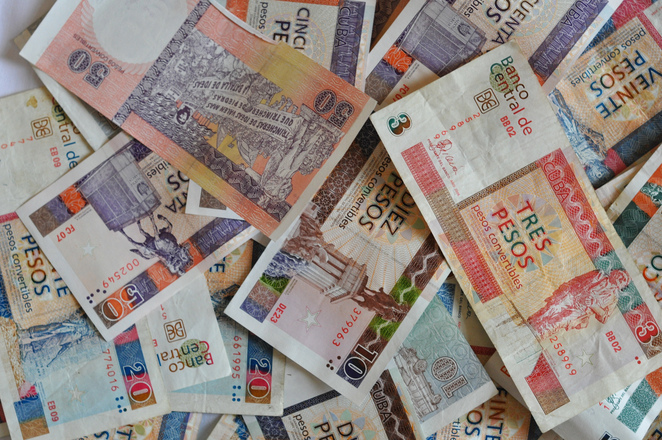
There is mixed advice out there on whether it is necessary to convert USD to CAD or EUR before traveling to Cuba. Cuban money exchanges (“Cadecas”) will take USD, but a 10% fee is charged to convert money from USD to the Cuban CUCs because USD is otherwise useless on the island. The exchange rate is 1:1 for USD to CUC. Assuming the exchange rate of USD/CUC to EUR is 1.25:1, you have the following scenario: if you bring $1250 USD to Cuba, you will receive back 1,087.50 CUC (1,250 CUC minus the 10% USD transaction fee of 125 CUC, minus the standard 3% exchange fee of 37.5 CUC). If you first change your USD to EUR before leaving the U.S., you will exchange $1250 USD for 970 EUR (1000 EUR for the exchange rate minus the 3% transaction fee of 30 EUR), and then exchange 970 EUR for 1162 CUC (1198 CUC for the exchange rate minus the 3% transaction fee of 36 CUC). You see that by first exchanging your money to EUR you receive 75 CUC more for your $1250 USD, even with the double transaction fee.
When you are leaving Cuba, because the Cubans want to get rid of their USD, there is no 10% transaction fee, so you can just exchange all your CUCs back to USD minus the 3% transaction fee again. You may also run into airport workers such as janitors or security guards who are willing to convert your CUC to USD without the transaction fee. Usually these transactions are legitimate, though under the table from the government, but if you end up with a counterfeit bill you will have no recourse to reclaim your money.
Visa Requirement: Itinerary
To meet the requirements for the Support the Cuban People visa, you must maintain a “full-time schedule” of activities that “(i) enhance contact with the Cuban people, support civil society in Cuba, or promote the Cuban people’s independence from Cuban authorities; and (ii) result in meaningful interaction with individuals in Cuba.” Guidance on this requirement states that just staying in a private home, eating at private restaurants (paladares), and buying local goods from private vendors who approach you while you’re lying on the beach is insufficient; however, anything that involves actively engaging with locals that goes beyond this appears to be sufficient.
Full-time schedule is not defined in the law, so those looking to interpret this requirement have considered what it means to be a full-time laborer and a full-time student, and it is generally agreed that six hours per day constitutes a full-time schedule based on this analysis. You must participate in activities beyond residing in a private home and eating at private restaurants, but time spent interacting with locals at these places will count towards some of your six hours per day.
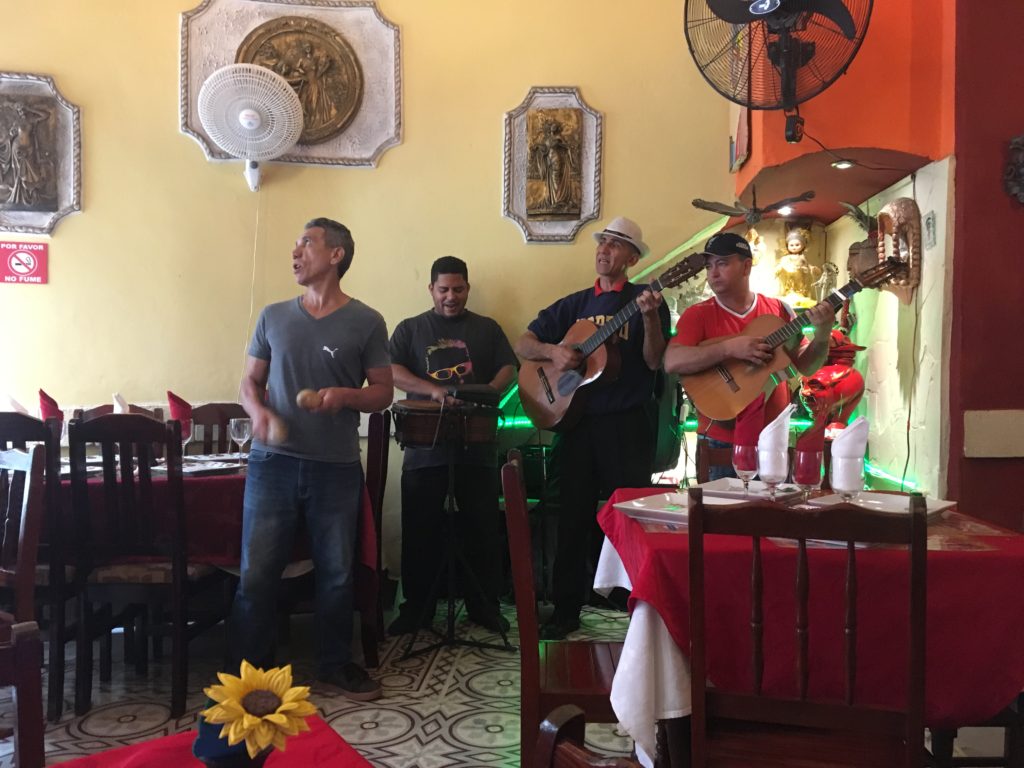
Musicians at a paladar restaurant, which clearly is also someone’s home.
It is recommended you set a full itinerary for yourself before traveling to ensure that you will meet the requirements. Visiting local museums and galleries, such as the Revolution Museum, Museum of Beautiful Arts, the Almacenes San Jose market, and Fusterlandia will count towards your itinerary, as well speaking with a local who gives you a tour of the city in his hot pink 1956 Chevrolet convertible. You may also book tours and activities via AirBNB experiences: anything listed here should count towards your full-time schedule as well. A day-trip away from Havana to see how Cubans live outside the city is highly recommended, as is a half-day bike tour around Havana. If you book tours online ahead of time you will not have to worry about spending your precious cash to pay for them in the country.
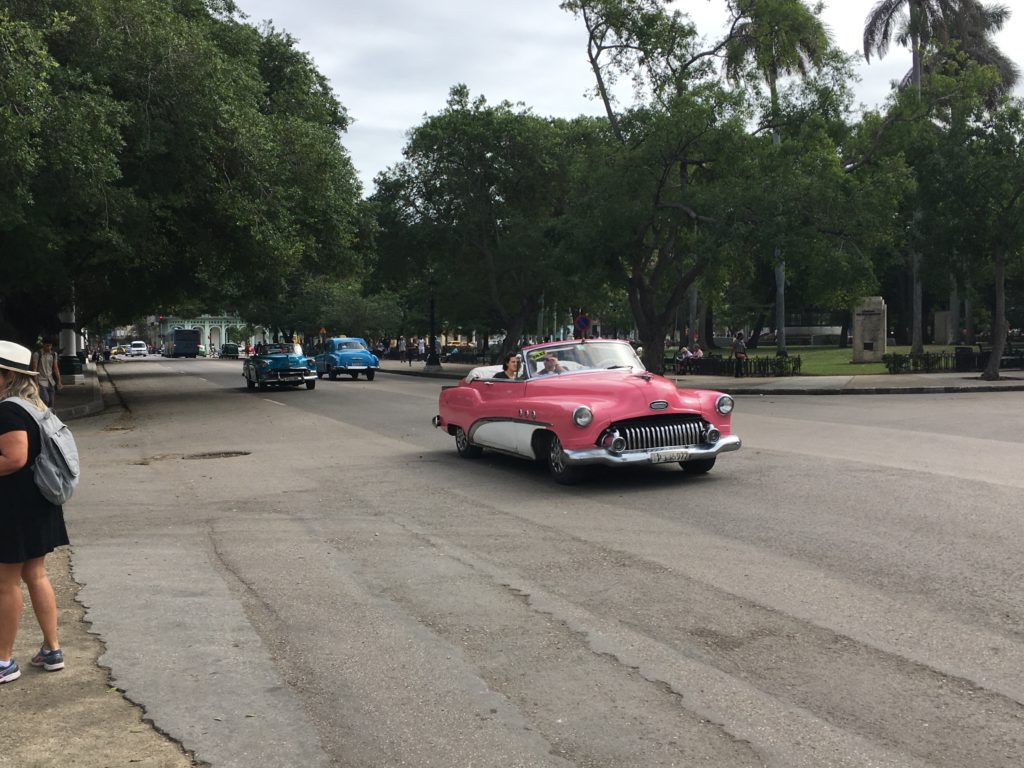
Tours in Old Cars
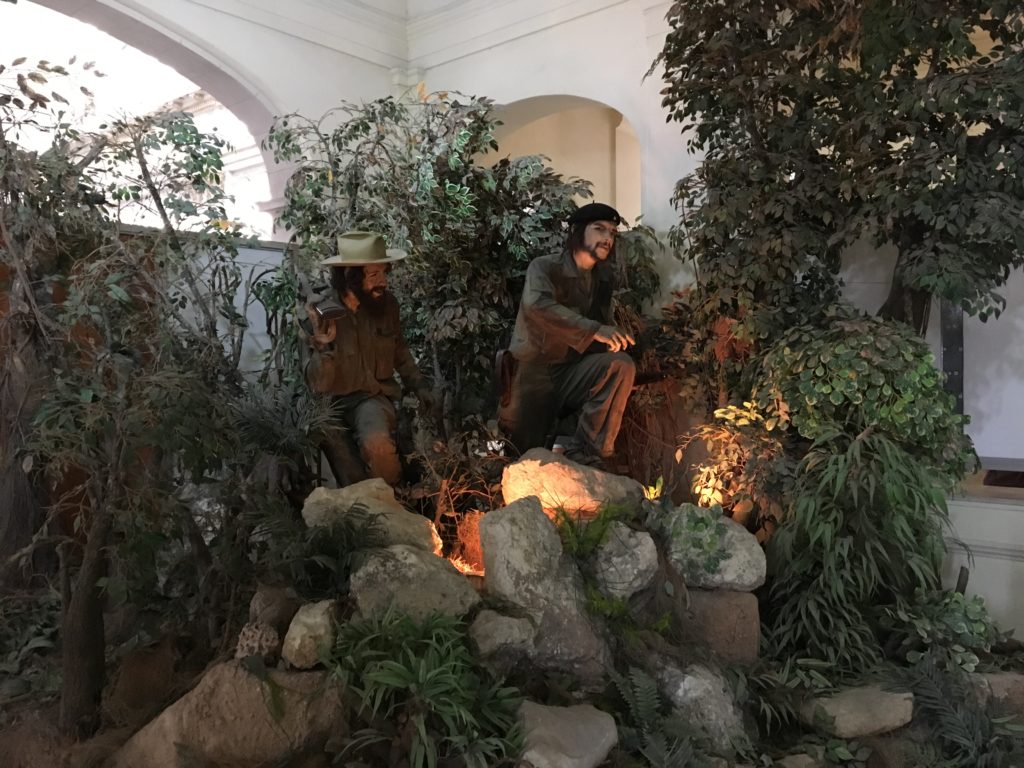
Visiting the Revolutionary Museum
You should research paladares to include in your itinerary before heading to Cuba, and try to make reservations at least for dinner for all of them ahead of time. Top recommendations include La Guarida, Locos por Cuba, El Del Frente, and La Cocina de Lilliam. For a nominal fee ($1 to $2), most reservations can be set up ahead of time using the website A La Mesa, the Cuban version of Open Table.
Arrival in Cuba
Money (again, it’s that important)
I cannot emphasize enough how you should just exchange all your foreign currency at the airport as soon as you arrive. The exchange rate will be exactly the same anywhere in Cuba, but doing this at the airport is quick and convenient, and you won’t have to interrupt your vacation for it again if you run out of CUCs later on. In one terminal there are ATM-looking machines that will complete the transaction for you. While there is mixed advice in this area, and in theory there are CADECA money exchange banks available in downtown Havana, the line to get into the bank can sometimes be over an hour long, and banks are often open at inconvenient times. The people in line and bank tellers will also only speak Spanish, so if you only speak English this transaction will be much more difficult than at the airport. You also need your passport with you to exchange money at the bank, and this is something you do not normally carry around with you in Cuba. Save yourself the time taken out of your vacation and just exchange all your foreign currency to CUCs at the airport (I certainly wish I had).
Getting Downtown
There are many normal yellow taxis waiting outside each terminal at Havana’s airport to bring people downtown. The price to get anywhere in Havana should be 25-30 CUCs. It is a set price: do not let yourself be talked into paying more unless you are considerably out of the way. To give you an idea, the ride to the intersection of San Lazaro and Calle Galiano from the airport was 25 CUC. Remember how much it cost to get downtown from the airport and don’t pay any more than that to return at the end of your trip either. This is a good rule of thumb for any taxi ride in Havana: if you only paid 15 CUC to travel from the Almacenes San Jose market to the Hotel Nacional, don’t then pay 20 CUC to return half the distance to your accommodation. Remember, you only have access to the cash you brought with you, so you are not being selfish by protecting it, you’re being smart!
Around Havana
Transportation
The easiest way to get around Havana is walking or by taxi, depending on how far you’re going. Taxis are plentiful around most tourist parts of the city and hotels, but be sure to negotiate or at least ask the price to a destination before accepting a ride! Most casa particular and AirBNB hosts will help you negotiate the price from your accommodation, since they know how much rides should cost.

Riding in the backseat of an old car
If you are brave enough to try local transportation, you may want to hop in a Taxi Colectivo! These cost about $1/person. They run set routes along major roads but will stop anywhere along the route to pick you up or let you off, just verify the general direction you’re heading before you get in. To flag a Taxi Colectivo down, stand on a main road and wave your finger up and down about waist height. These taxis seem to be safe, but be warned you may encounter some unique individuals riding in them….
Other available forms of transportation include rickshaws powered by bicycles and Coco Taxis, which are yellow, open-air motorized pieces of metal run by what appears to be a moped. There are no seat belts, they move rather slowly, and there is no protection from the elements if it starts to rain, but these can be a cheap way to get around short distances.
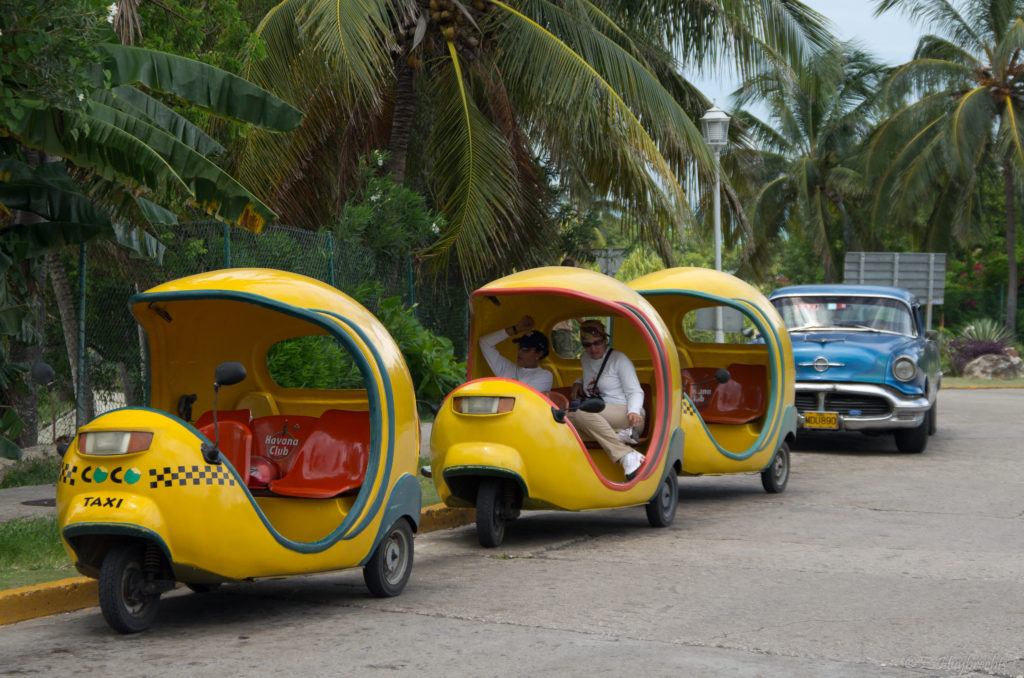
Coco Taxis
Regardless of how you intend to travel, you should download the maps.me app to your smartphone as well as the map of Cuba within the app before you leave the U.S. This app is minutely detailed and operates without WiFi. Even if your phone is on airplane mode it can locate you using satellites and provide walking or driving directions to any other location on your map. It is one of the most useful travel apps not just for Cuba but for any foreign destination.
Making Purchases
A requirement of the U.S. government regardless of which visa you travel to Cuba on is that you are forbidden from spending money at institutions that are government- or military-owned. A full list of these places can be found here. Aside from these entities, you can spend your money wherever you’d like!
If you intend to purchase cigars or alcohol, know that prices of these goods are controlled, so you will not find a better deal by shopping around. The easiest way to purchase cigars, alcohol, and coffee is at the airport right before you leave. There are shops available outside security if you’d like to place these items in your checked luggage (as would be required with bottles of liquid larger than 100 ml). Otherwise, feel free to and please do purchase souvenirs such as jewelry, paintings, and humidors from local vendors throughout the country as another way to support the Cuban people during your visit.
Safety
So long as you take precautions you would in any big city, Havana is totally safe. Because Castro’s government gave everyone a house when he came into power there are no homeless people. There are also strict laws against harassing foreigners as Cuba would like to build its tourism industry. Nevertheless, while I felt safe walking around even dark roads at night, I still wore a cross-body bag and kept my hand on my purse at all times, though this may have been unnecessary: I did not see or hear about any instances of theft or pick-pocketing. Generally if the Cubans are going to try and get money from you, they will do so openly.
A story of caution: on my first day in Havana, my dad and I arrived at the airport around 8am, and went through immigration, the health check (turning in a form that says you’re healthy) and customs without paying too much attention to the people we interacted with. Later that day walking down a very busy main tourist road in Havana, we were approached by a local who “just wanted to practice his English” and welcome us to his city. He asked where we were from and when we arrived. He also mentioned that if we wanted to buy cigars there was a huge monthly festival a few blocks away that was selling them for half-price from the factory workers. He then insisted he didn’t want anything and bid us good day.
A few minutes later as we were standing outside a restaurant contemplating lunch, a woman who spoke almost perfect English came up to us and said “the Americans! I saw you this morning, I’m an immigration officer! How are you liking Cuba so far?” At the time, my dad and I both thought the other person recognized her from the airport: in hindsight, she was clearly working with the guy up the road, who had gathered enough information for her to approach us. This interaction was followed up by the woman also mentioning the cigar festival and offering to take us there. Not realizing the two were working together at the time, the festival now seemed legitimate, as two separate locals knew about it. There was no festival: instead we were led down a somewhat deserted side street and into an apartment building where the exit was locked behind us. At that point, I gave us a 50/50 chance of being either robbed or killed. We were offered boxes of what I’m sure were fake cigars at “half price,” and were only allowed to leave when I insisted I had been asked to buy Romeo y Julietas by a friend (which was true), and these people did not have that type of cigar. After leaving the apartment, the woman insisted on showing us to a “fantastic” restaurant for lunch, and then requested $10 for her and her poor baby. We ended up giving her $5 and said that we couldn’t afford any more at the time since we were limited to the cash we brought with us and weren’t sure how much we would need, which was true.
In the end, we learned a $5 lesson when it could have been a $300+ lesson, and also got to include this encounter in our journals as an hour of”interacting with locals learning about the cigar industry.”
Returning to the U.S.
You will enter the U.S. and go through immigration and customs at the airport at which you land when you first return from Cuba. My experience going through immigration and customs was no different than returning from any other trip abroad. When asked what my purpose was for going to Cuba, I promptly said “to support the Cuban people” instead of “tourism,” and the officer smirked and let me go with no other questions. I’ve heard stories of Americans returning who have been asked by an immigration officer to produce their daily journal of activities (the itinerary or a bullet list should count), photos of all their receipts, and photos of the entire trip to prove the itinerary was followed, so you should be ready to produce those if necessary. You also must maintain all of these things for five years after you return in case you are audited by the Department of the Treasury. Note that even if you are not a U.S. Resident and you are just passing through the United States on a connecting flight back to your country, you will still need to meet one of the 12 U.S.-approved reasons for traveling to Cuba and possibly produce the proof listed above to a customs officer.
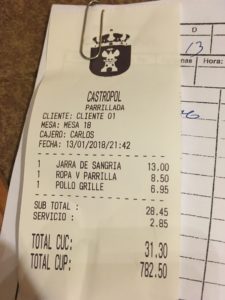
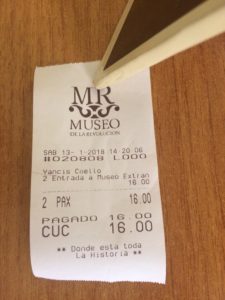
Photos of receipts for potential audits
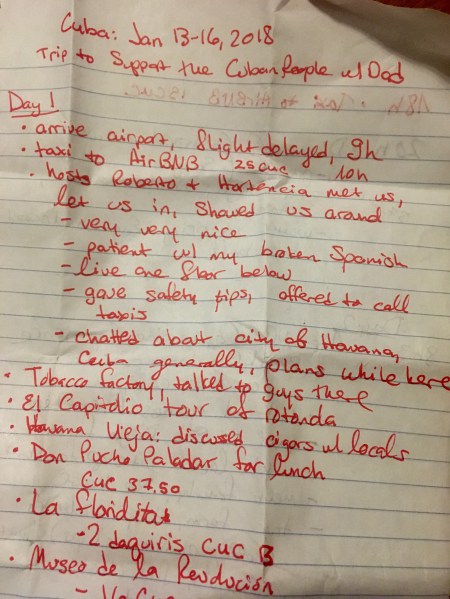
Example of “journal” kept in case of audit
For customs, U.S. Residents (citizens and legal permanent residents) over 18 or 21 are allowed to bring back (for personal use or gifts, but not resale) 1L of alcohol, 200 cigarettes, and 100 cigars. As with returning from any foreign country, U.S. Residents are limited to $800 total of goods brought back into the country for personal use and gifts. Therefore, even though you are allotted 100 cigars, if you purchase 100 Cohibas at $10 per cigar, you will exceed your $800 customs limit. To get around this you may split up items among your 18+ or 21+ family members and/or travel companions: e.g., if you want to bring back 100 Cohibas at $10 ($1000) and your wife wants to bring back 2L of rum ($20), you can each claim 50 Cohibas and 1L of rum for $510 each, which puts you under both the quantity and monetary personal customs limits.
In conclusion, it was considerably easier and cheaper to visit Cuba than I ever thought, so if you have any interest in seeing this beautiful country I would highly recommend it!
Love this post? Save it to Pinterest for later!
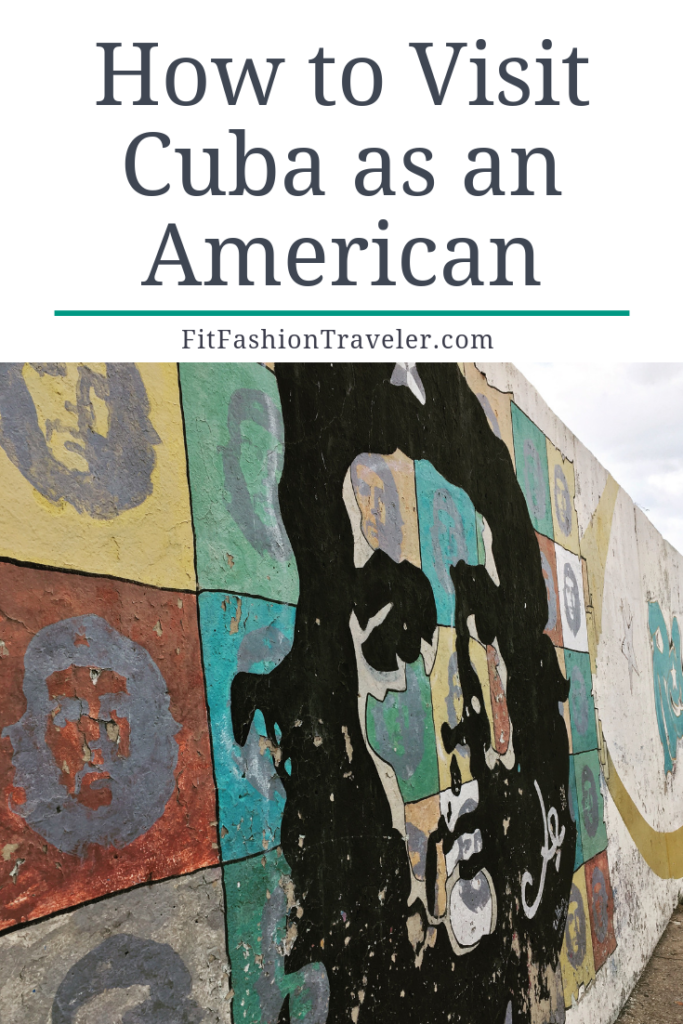

by Kelly | Mar 14, 2018 | Caribbean, Cuba, Day Trips, Havana, Travel
Cuba has been my top bucket-list destination my entire life, and this past January I made that lifelong dream come true with a weekend in Havana! Most Americans think Cuba is off-limits for travel unless you have family living there or want to go with a humanitarian volunteer group, but after my roommate and her friends visited in December I realized how easy it is to travel there legally.
Are you an American wondering how to visit Cuba legally without an expensive tour group? Check out my post on How to Travel to Cuba!
Starting the trip
This past winter was brutally cold in New England, so when I suggested to my dad that we check out Cuba instead of our annual Martin Luther King weekend trip to Mount Tremblant in Canada, he was completely on board. We booked our flights and AirBNB accommodations, created our itinerary, reserved our activities each day, and two weeks later were headed for Havana!
Old Havana
We arrived in Havana early Saturday morning. Our AirBNB host met us at the apartment and let us in early so we could drop our bags before wandering around the city. Our hosts, Roberto and Hortencia, were the most helpful AirBNB hosts ever! They spoke no English and were very patient with my broken Spanish as they explained the apartment and surrounding areas. Roberto even offered to give us a guided walking tour of the city, but seeing as my dad doesn’t speak Spanish and I was already exhausted from an hour of communicating with them, I wrote down Roberto’s suggestions and we were on our way.
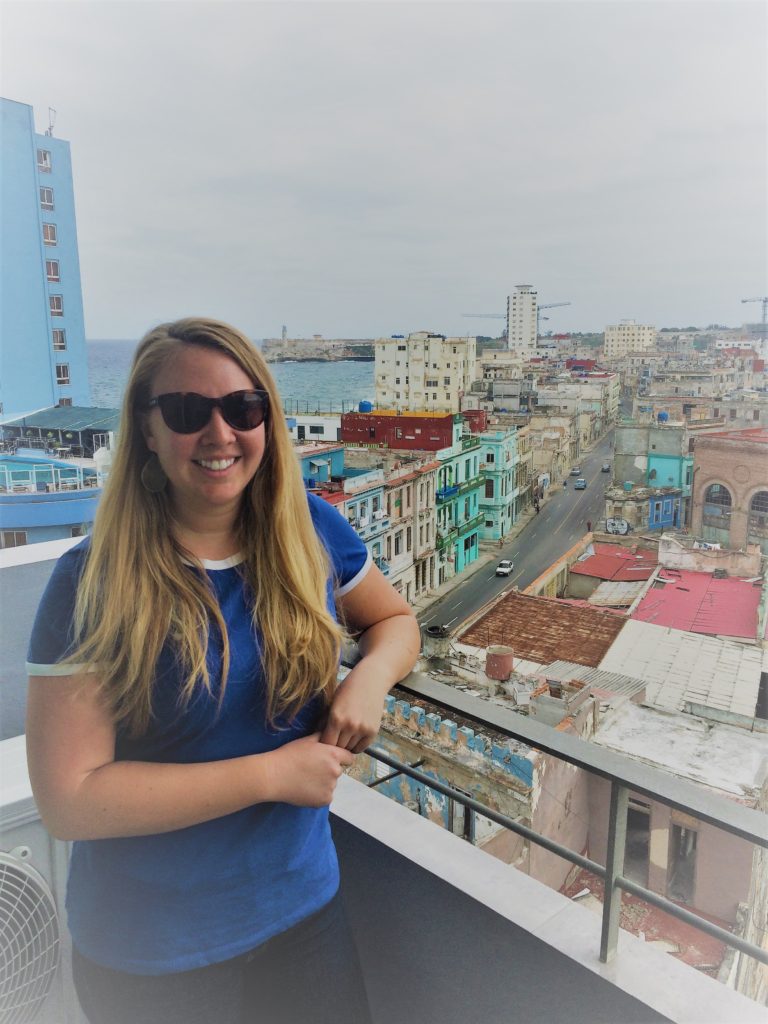
Photo from the AirBNB Balcony overlooking Havana and El Malecon boardwalk
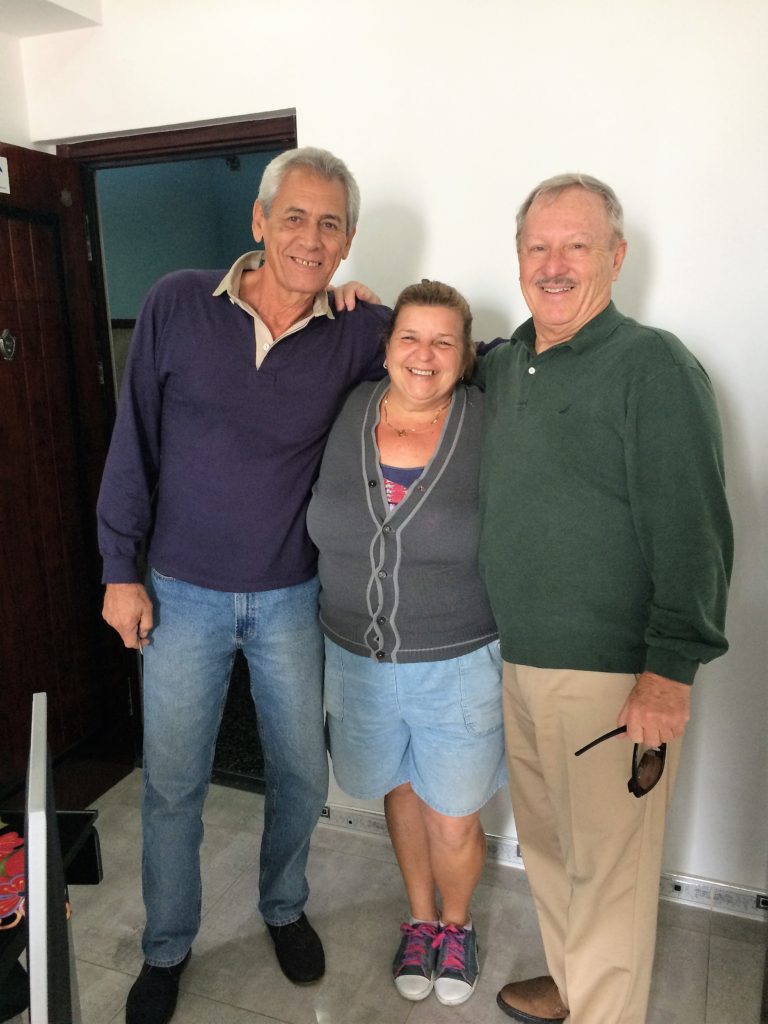
My dad (right) with our incredible hosts Roberto (left) and Hortencia (center)
Fabrica de Tabac
Our first stop was the Tobacco Factory (Fabrica de Tabac), which unfortunately was closed for repairs. We noted the prices of cigars for later and continued on our way. Note that cigar and alcohol prices are fixed in the country, so you will not get a better deal by shopping around, and if a local offers you a “better deal,” they are probably selling fake products.
El Capitolio
Next to the factory was El Capitolio, the capitol building and entrance to Old Havana. El Capitolio should look familiar, as it is modeled after the U.S. Capitol building. We went inside for a free tour of the rotunda, where the national symbols are on display as well as the tomb of the unknown soldier. I was most surprised to see the American flag on display along with all the other flags of North and South America, representing countries that helped shape Cuba’s history.
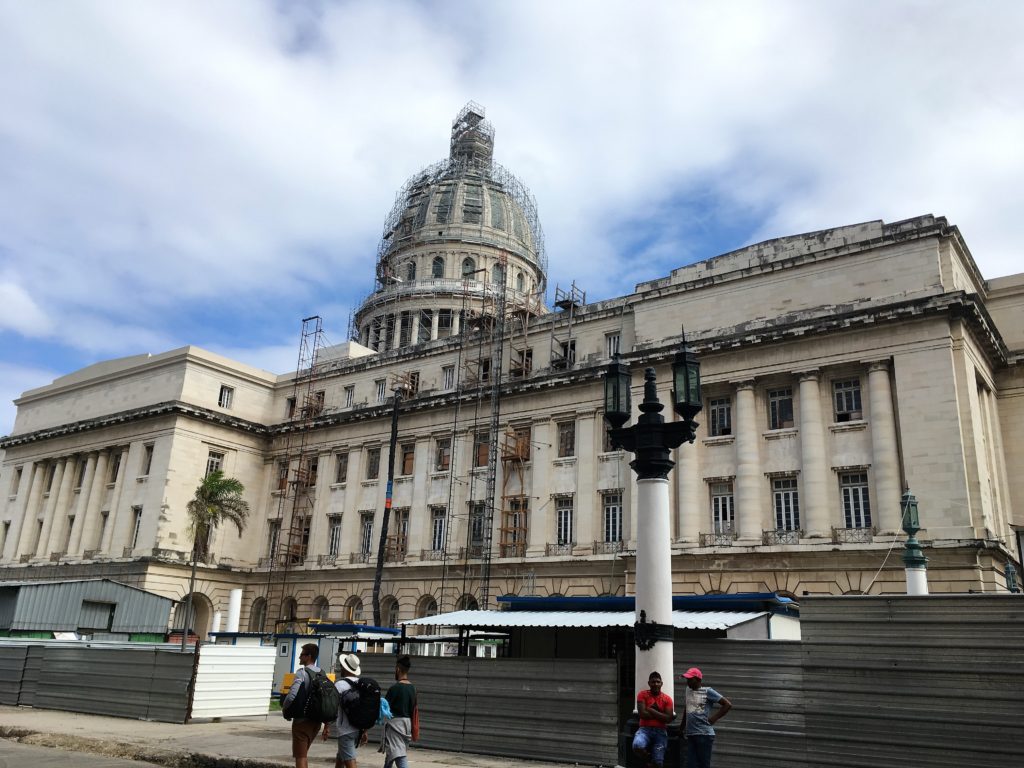
El Capitolio, under construction
La Floridita
Next we visited the La Floridita bar and restaurant, origin of the daiquiri and a favorite haunt of Ernest Hemingway, who lived in Cuba for many years. My dad and I each enjoyed an original daiquiri, which is lime-based and refreshing, rather than sweet like American strawberry daiquiris. If I were to return to one place in Havana for a drink, this would be it.
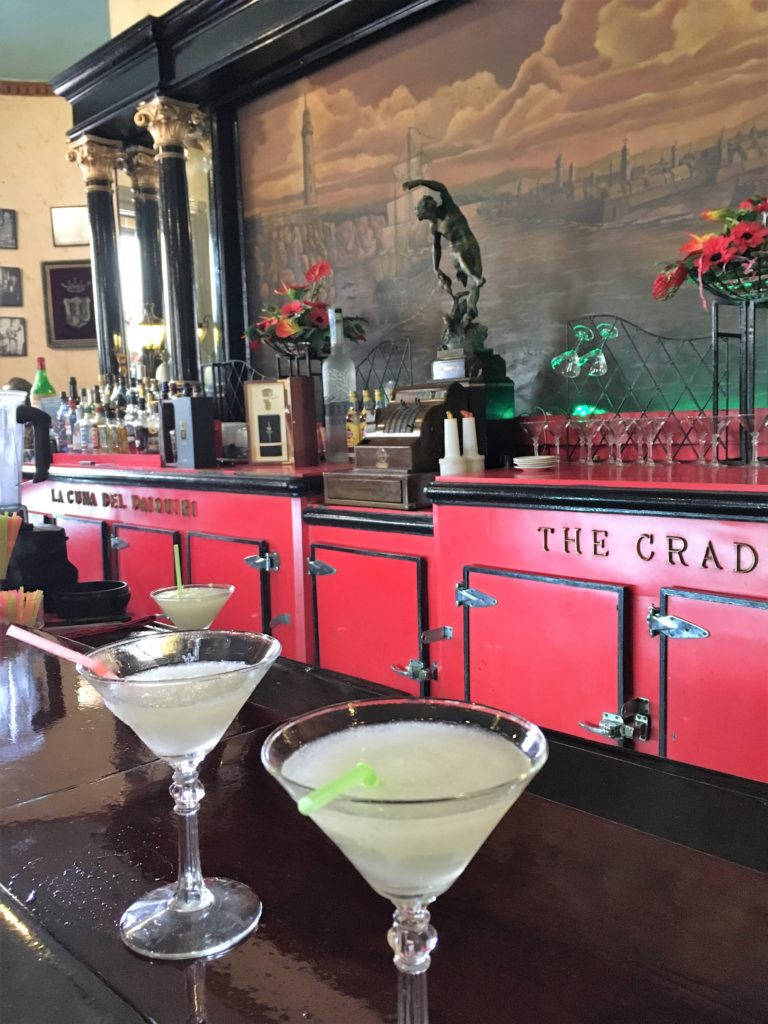
Museo de la Revolucion
After our drinks, we wandered over to the Museo de la Revolucion. Here, we learned so much about the years leading up to the Revolution before the January 1, 1959 overthrow of which the world is aware. There was also a lot of information about Che Guevara and Camilo Cienfuegos, two of Fidel Castro’s right-hand-men during the Revolution. After Cuba was won for the Communists, Che went to fight in Bolivia where he was killed by the CIA, and it is rumored that Camilo was offed by Castro shortly after he came into power to avoid a power struggle or a second revolution of the people more in favor of Camilo.
La Bodeguita del Medio
Continuing with our itinerary, we went to try a mojito on the roofdeck of La Bodeguita del Medio, the birthplace of the mojito, before venturing down to the Almacenes San Jose market. Here I found jewelry and beautiful artwork to purchase from the Cuban people. The market contains your typical souvenirs, so there is nothing particularly fancy, but it’s a fun place to look around and find something to pick up both as a memory from your vacation and in support of the local vendors.
Hotel Nacional
Our last stop of the day was the Hotel Nacional, a large modern, luxury hotel on the waterfront El Malecon boardwalk. We thought the hotel must be government or military owned, so we just walked around without purchasing anything, but we found out later that it is privately owned so it is possible for Americans to have a drink and make purchases there. The coolest part of the National Hotel is the bunker system in the back from the days of the Cuban Missile Crisis. My dad was old enough during the crisis to remember the crisis it happening, and his older brother was in the Air Force at the time ready to respond if an incident took place. With this perspective it was fascinating to hear my dad’s thoughts on the bunkers, the most interesting being the realization that the Cubans were just as afraid of Americans shooting missiles back at them as we were of being shot at from Cuba. During our trip we also learned that the Cubans had no control over the missiles: the largest Soviet military presence in Cuba occurred when the missiles were placed there, not because of the American threat, but to prevent the Cuban people from taking the missiles from the Soviets.

Night One Dinner
For dinner walked to a restaurant on the water front to enjoy a pitcher of sangria and the most typical Cuban dish, ropa vieja. Literally translated as “old clothes,” this dish of shredded beef and tomatoes had the perfect amount of spice and tenderness for me to say it was the best ropa vieja I’ve ever had! After dinner, our itinerary included a night out with live music, but we were so tired from the traveling and walking of the day that we went right to bed. We had also been thinking of visiting Club 1830 for salsa dancing, but it was raining and we were told that the club doesn’t have a roof, so we would be the only ones there if we went!
Interested in your own Havana Itinerary? Check out the article One Day in Havana.
Countryside Day Trip
Breakfast
The second day of the trip was filled with a 10-hour tour into the countryside to see how Cubans outside Havana live. We began the day with breakfast at Locos por Cuba, where we met our tour guides Alex and Leo, two young economics and political science professors at the local Universidad de la Habana. We also joined up with the four other visitors, a couple from San Francisco also in Cuba on the Support the Cuban People visa, and two friends traveling together from Florida and Maine who were visiting on an educational visa (they were establishing connections for a return trip with community college students later this year).
On the Farm
After a two-hour van ride to Viñales, during which the driver stopped at a true pit-stop – a guy standing on the side of the road selling food and drinks he kept in the woods behind him – we arrived at our farm for the day and met the local family. When Castro took over Cuba and implemented Communism, all families were given a house, and those in the countryside were also given land. Because of this, there are no homeless people in Cuba! However, there is also no money to buy additional property, so generations of families live in the same house their family was provided in 1959. On this particular farm lived the grandmother, the father and mother, and at least three children. The house contained exactly five rooms: a kitchen, a bathroom, two bedrooms, and a dining/living room. It was not a lot of space for a large amount of people, but the family didn’t seem to mind.
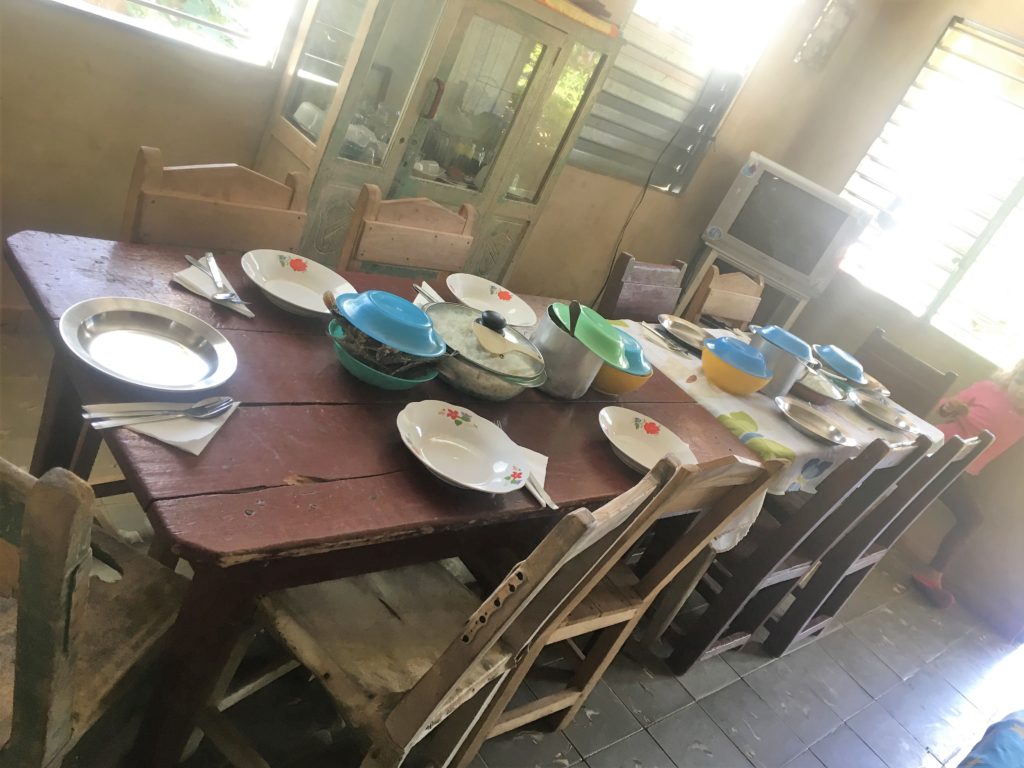
Table set for 9 by our gracious hosts in their living/dining room
Everything from the Land
We began our tour tasting the different fruits of the farm. The entire property is self-sustaining, with everything they need for consumption found on their own land. We tasted fresh oranges, plantain chips made in front of us from plantains picked from the farm, and coffee that was grown, harvested, roasted, and ground on-site. Even the water was collected and purified on the property, and the fish we had later for dinner was caught in the river running through the farm.
Exploring the Property
After exploring the area around the house, we went on a hike through the many acres owned by the farmer and his family down to the river and bat cave. We crawled our way through the bat cave until we were standing right under the bats: it was recommended we all wear hats for this part to avoid bat droppings on our heads.
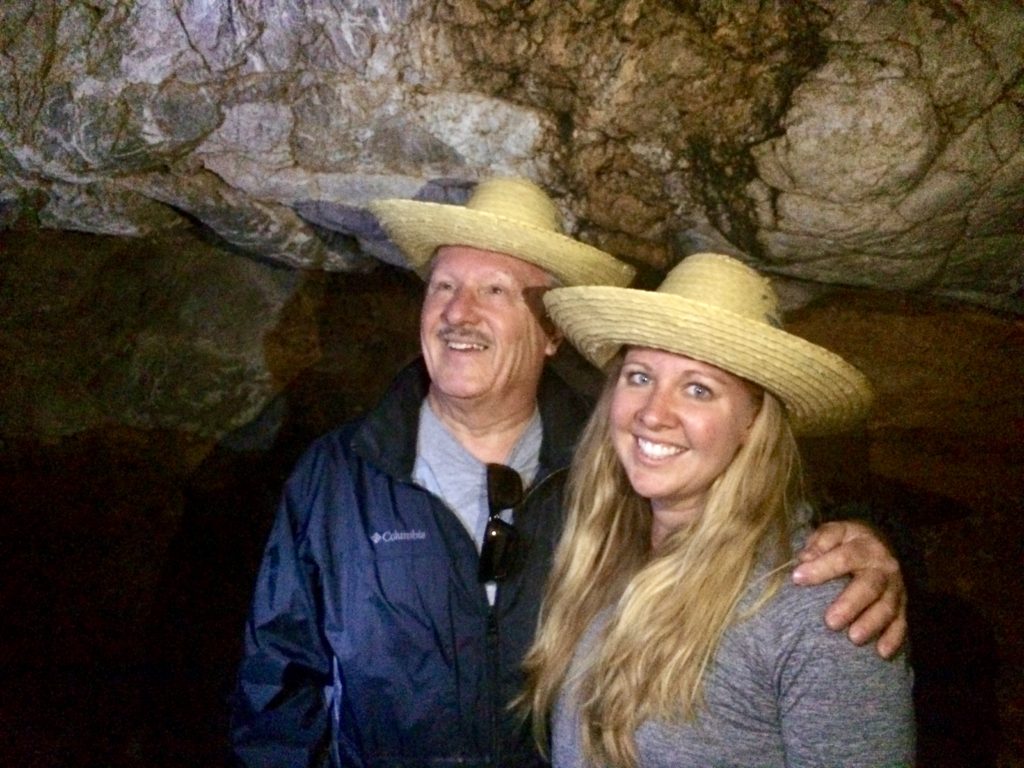
Smiling, but also afraid the bats a few meters above us would wake up and notice our presence
On the way back from the cave we stopped by the river for a swim and to learn more about life in Cuba from our guides and the farmer we were visiting. It was wonderful to hear our guides sharing their opinions, both positive and negative, about various aspects of Cuban life, economics, and politics. One of the guides stated that he would like to see more democratic and capitalistic features in Cuba, but also to maintain the free education, healthcare, and housing on which so many people rely.
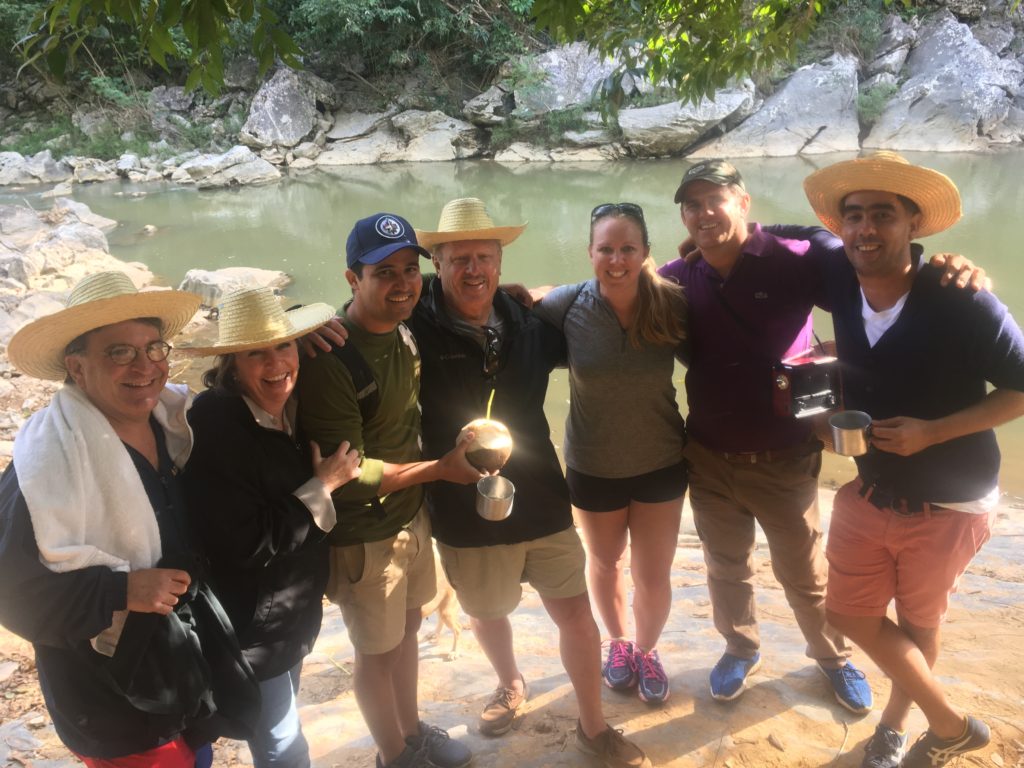
Family Dinner
Finally, we were invited to share a meal with the family before heading back to Havana for the evening. The experience we had that day on the farm is something I will never forget, and I definitely encourage anyone who visits Cuba to consider this experience!
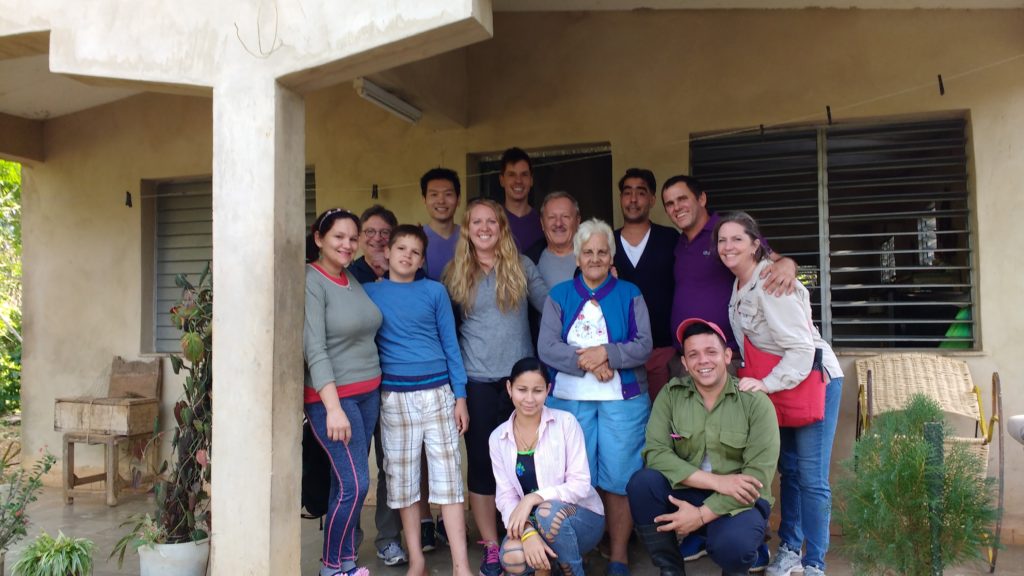
Fitness In Havana
Our final full day in the country included a 5-hour bike tour of the city in the morning, followed by rooftop salsa dancing lessons from locals in the afternoon. I was really looking forward to this day, especially the salsa dancing, but unfortunately got sick the night before. Regardless, I still went out and made the best of it, though every time my dance instructor asked if I was ok, all I could replay was “sí, sí, estoy bien,” rather than “I’m just trying not to throw up on you.” Please learn from my mistake and don’t let your guard down on any raw or potentially unwashed food in the country: I think that may have been my downfall!
Morning bike tour
Taking a bike tour allowed us to experience many areas of Havana that would have been difficult to get to from our AirBNB. The start of the tour was in the Vedado area of the city, which gave us the opportunity to ride in one of the classic car taxis! While my dad was very disappointed to learn that the only original part was the body, and that the engines were all old Soviet car engines from the 80s and the 90s, we were happy to get our old-car ride in for the trip.
The main stops of the bike tour included the Havana Forest, Columbus Cemetery, Revolution Square, Old Square in Old Havana, and El Malecon. Our tour guide was another professor from the Universidad, and our tour companions were two young British girls in Cuba on holiday for a week. Taking a bike tour in Havana is a great way to experience a large part of the city while also getting in your vacation exercise!
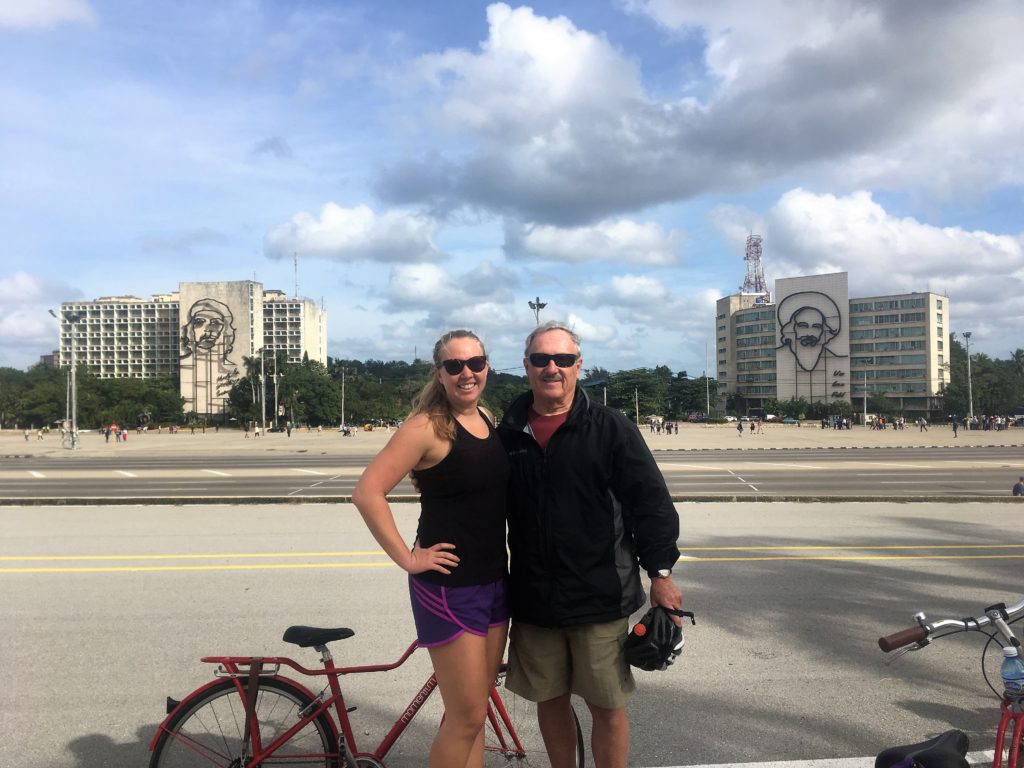
Metal sculptures of Guevara and Cienfuegos flank Revolution Square. As Castro would stand at the front and make his speeches to a filled square, his two other revolutionaries would be looking back at him.
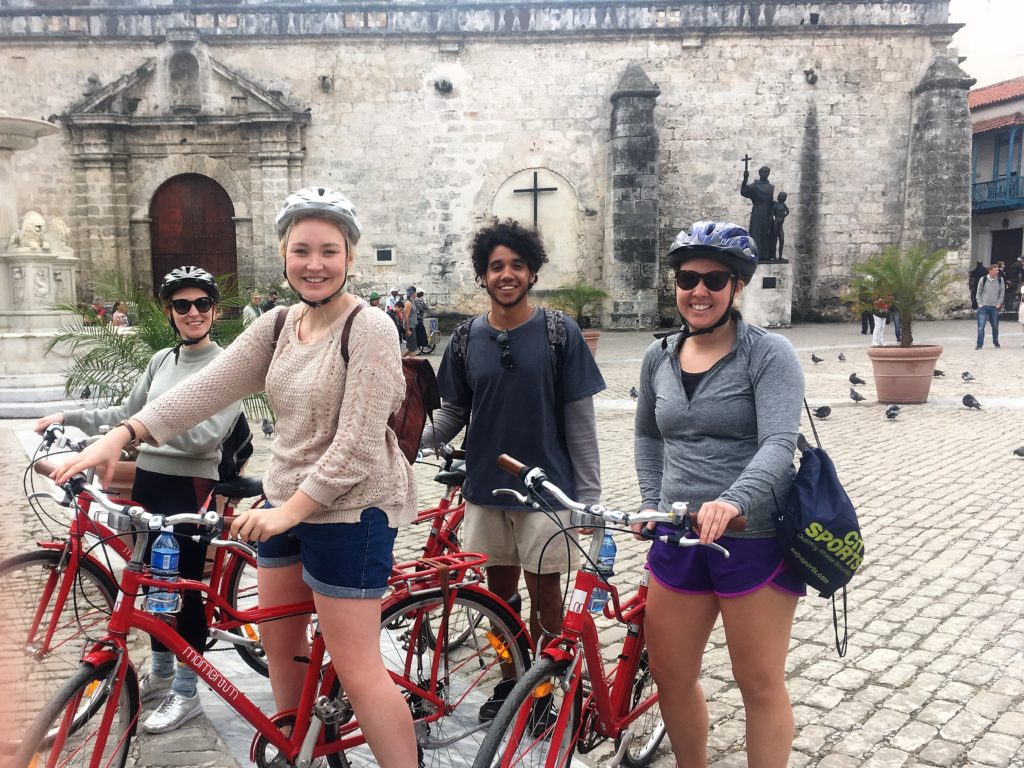
Two British companions and our tour guide in Old Havana
Afternoon Salsa Dancing Lesson
For our last afternoon, we had signed up for rooftop salsas dancing lessons. We were picked up from our AirBNB, brought to the studio, and matched up with partners based on our gender and abilities (I have many years of basic salsa experience as well as other dance experience, while this was my dad’s first time learning it). Having a private lesson for over 2 hours was so much fun! My instructor began by dancing with me, and when we would try a move I was clearly unfamiliar with he would stop, teach me the move, and then continue dancing to practice. I felt like I was just out dancing normally, and yet had a dance partner who wouldn’t get frustrated if I was unfamiliar with something or messed up a move, but instead had unlimited patience to continue teaching me. My dad reported a similar experience with his instructor. After class we were returned to our AirBNB by the same driver.
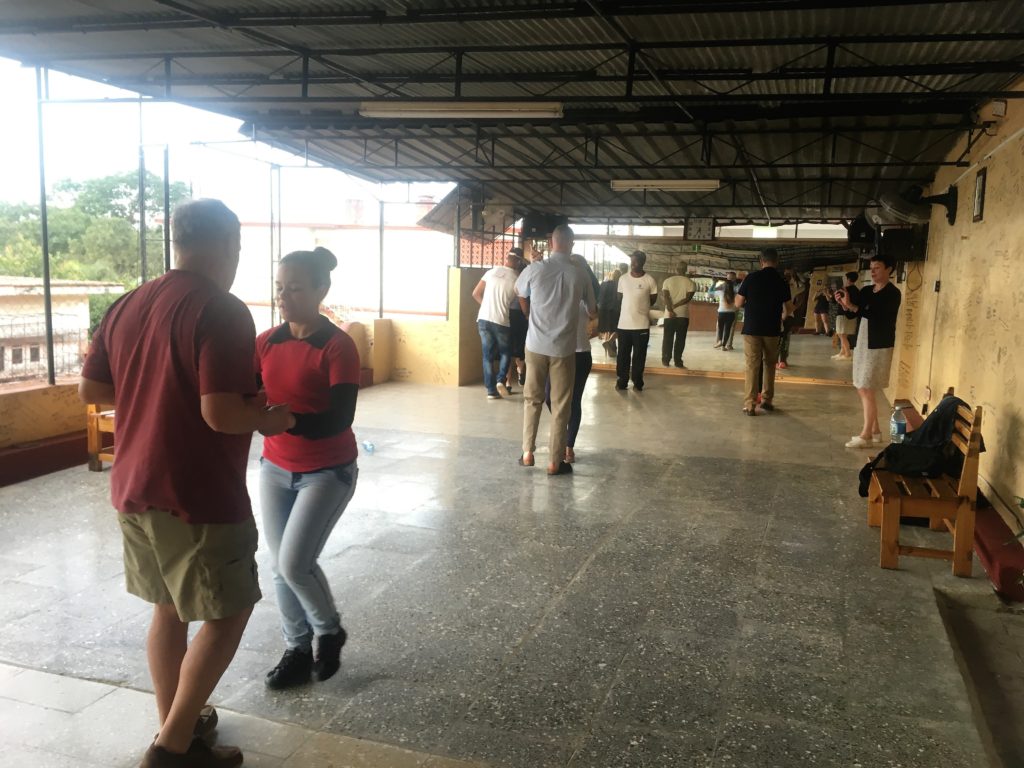
Final Dinner: La Guarida
We made it a point to book reservations far in advance for dinner at La Guarida, considered one of the best restaurants in Havana and the place where anyone who’s anyone stops by at least once when they’re in Cuba: Madonna celebrated her 58th birthday here, and Beyonce dined here with Jay-Z on their most recent trip to the city. The building – like most in Havana – looks on the outside like it was once beautiful but is now about to crumble down on top of you. Once you get past the bouncer, you climb up five flights of crooked marble stairs past empty floors that are now ghosts of their former glory and opulence. However, once you get by all this and reach the restaurant on the top floor you are in for a wonderful surprise: La Guarida would be considered fine dining even in the United States. The decor is contemporary and the space is small, with many different rooms and two small balconies seating diners, but you feel special from the moment you arrive, and the food and drinks are incredible! While I was still somewhat sick from the night before and did not get to enjoy the restaurant as much as I wanted to, I highly recommend it and cannot wait to go back and try it again next time I am in Cuba.

Final Thoughts
Cuba is not off-limits for Americans, so long as you don’t mind an active vacation that involves staying in an AirBNB and eating in local, family-owned restaurants. There are some precautions to take and things to know before you arrive, but the people are super friendly, the city of Havana is safe, and the country of Cuba has such a rich, unique culture that must be experienced firsthand.
If you are interested in staying in the AirBNB or participating in the activities described above, you can follow the links below. First-time AirBNB users can get a $40 credit here: www.airbnb.com/c/kellys8303.
AirBNB lodging
Countryside Experience
Bike Tour
Salsa Dancing Lessons
Love this post? Save it on Pinterest for later!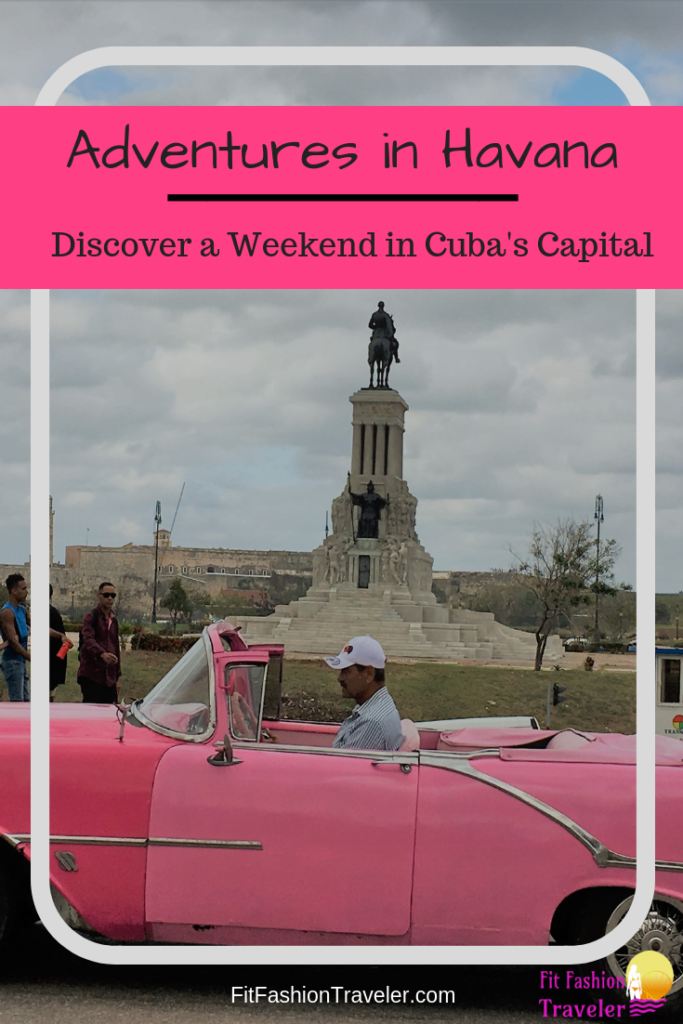
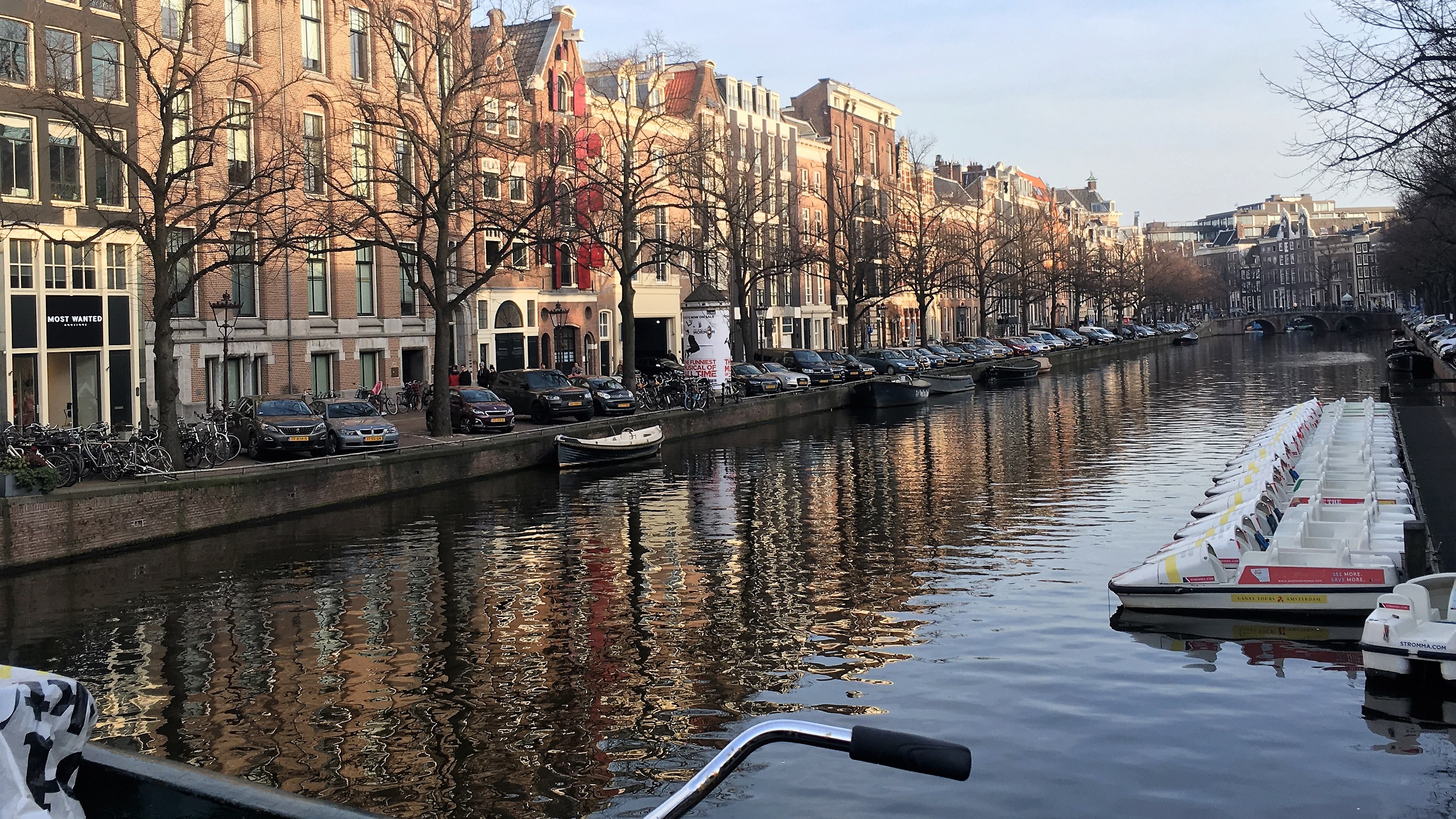
by Kelly | Mar 17, 2019 | Amsterdam, Europe, Netherlands, Travel
When you think of things to do in Amsterdam, the stereotypical Red-Light District and pot-filled coffee houses may come to mind. However, there are dozens of things to do in Amsterdam that have nothing to do with either of these activities! Amsterdam is a multi-cultural city with a rich history that will appeal to many travelers. Whether you are interested in museums, food, shopping, culture, or spending time outside, you will find something to enjoy in the Netherlands’ capital city. I went to Amsterdam for the second time about a month ago: here are the top 20 best things to do in Amsterdam that I discovered during my visits.
Best Amsterdam Museums
If you want to visit Amsterdam's museums, purchase the I amsterdam City Card. Before visiting the city I researched the card and decided against buying it. However, once I was in The Netherlands, I realized I would save money with the 48 Hour I amsterdam pass. The card allowed me to visit museums I may have otherwise skipped because they were essentially free. You can purchase the card online or at the Rijksmuseum store once you are in the city. All of the museums recommended below, and many more, are included with the I amsterdam City Card.
1. Rijksmuseum
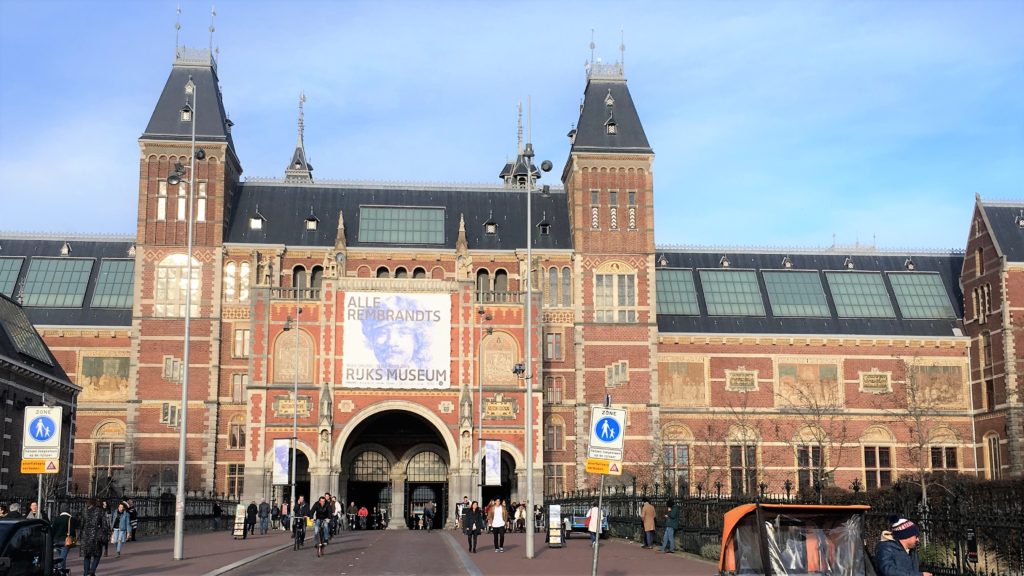
The Rijksmuseum is the most famous museum in Amsterdam. Its collection stretches a millennium from 1000 AD to the current era. Its most famous painting is Rembrandt's "The Night's Watch," and it maintains the largest collection of Rembrandt paintings in the world.
Some of the best things about the Rijksmuseum are the guides provided for the most famous pieces. They describe the background of each painting and help visitors appreciate details that may otherwise be passed over. For example, I learned "The Night's Watch” was named such centuries after it was painted because the canvas had become dirty, making it look as though Rembrandt intended to paint men gathering in the middle of the night. After restoration, it was clear that daylight shone through a window in the painting, but the name stuck.
2. Oude Kerk

The oldest building in Amsterdam is Oude Kerk or Old Church. Built in 1390, Oude Kerk sits on a canal in the Puritan Quarter of De Wallen, which is the Red-Light District. Ironic, right? While the church certainly stands out in the area, its structure is less imposing from the outside as you would expect from its size. I easily missed it the first time I walked by.
Stepping into the Oude Kerk's interior took my breath away. I was completely in awe. This is far from the first European church I've visited, but its vast space was nothing like I'd seen before. Not only is the interior large but it is almost completely empty. The center does not have pews, just a few chairs behind a wall facing a pulpit. There is a small music room off to the side with a piano available for playing that fills the entire space. Even if you’ve seen your fill of European churches, Oude Kerk is not to be missed.
3. Rembrandthuis
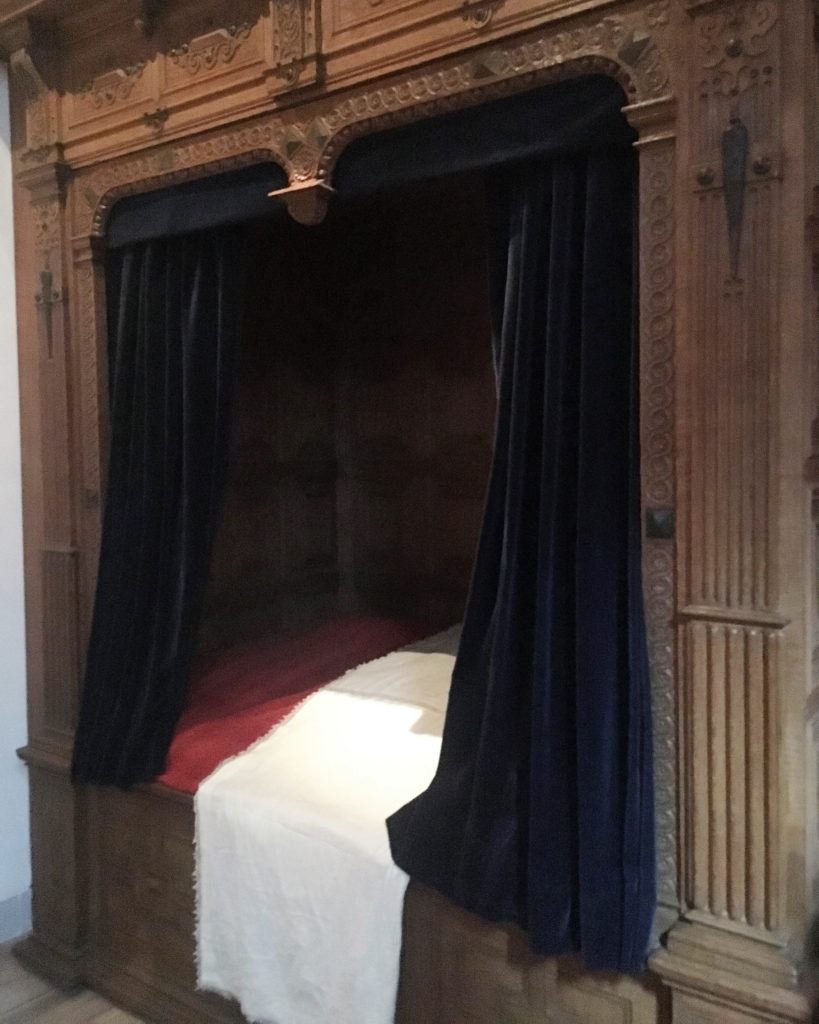
These "box beds" were so small because people in Rembrandts' era slept sitting half-upright: they believed if you fell asleep lying down all the blood would rush to your head and you would die! Sounds uncomfortable to me.
Rembrandt was once a wealthy inhabitant of Amsterdam’s city center. He had a multi-story house sitting on one of the canals that he lived in and used as a painting studio. Unfortunately, he went bankrupt and all of his things were sold to pay off his creditors. Visitors to Amsterdam can visit Rembrandt’s house to learn how he lived and see his living quarters, but most of the things in the house are replicas of items he may have owned, as his real items are lost to history.
4. Van Gogh Museum


Van Gogh is another famous Dutch artist whose work is featured in Amsterdam. Visit the Van Gogh Museum to see his famous “Sunflowers” still life and his self-portrait, both painted in the late 1800s when he lived in the South of France. Though you may have seen recreations of these and other Van Gogh paintings before, viewing them in person in the museum brings them to life. Visitors can see how much the colors he used pop off the canvas and can study the details in the paintings that you can’t see in a photo or recreation.
5. Resistance Museum
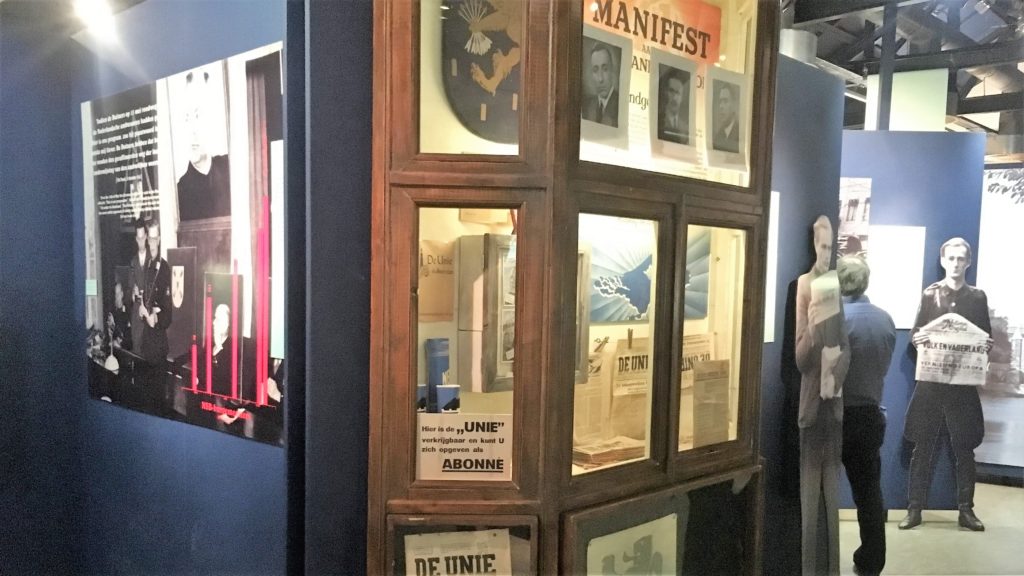
The story of World War II for The Netherlands is much different from that of many other European countries. In May 1940 the Nazis leveled Rotterdam in a bombing campaign. They threatened to do the same to Amsterdam and other Dutch cities. As a result, Dutch Queen Wilhelmina surrendered to prevent additional destruction and loss of life and fled to the UK. The Nazis invaded and took over the country.
The Resistance Museum tells stories of various Dutch citizens during the war. It describes how the Nazis initially treated most of the Dutch well because of their shared Germanic roots. The museum includes stories of Dutch citizens who thought Nazi rule was the new normal and joined their ranks, citizens who tried to mind their own business during this time, and citizens who supported the underground resistance efforts. The matter-of-fact inclusion of all these stories provides an in-depth look at life in The Netherlands during World War II.
6. Tulip Museum
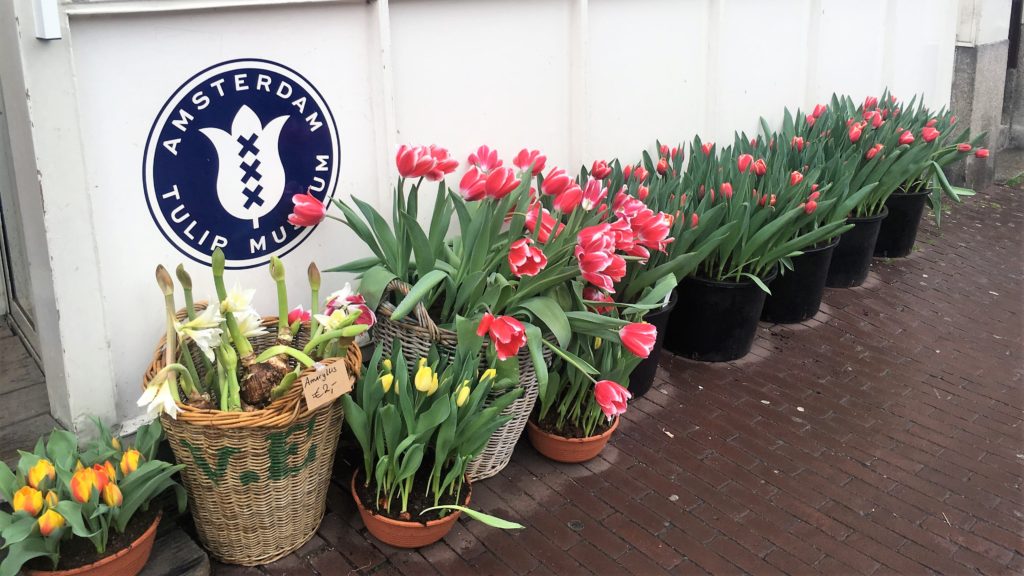
A visit to The Netherlands wouldn’t be complete without learning about its famed flower, the tulip! If you have the chance, get out into the country and experience the tulip fields for yourself. For a shorter trip, check out Amsterdam's Tulip Museum.
Admittedly this is a museum I wouldn’t have visited if I had to pay for it separately. I’m glad it was included in the I amsterdam City Card because it was fascinating to learn about the history of the tulip.
Did you know tulips are natively from Central Asia? Tulips were brought to The Netherlands by travelers from the Ottoman Empire. It was considered a flower of royalty because of its rarity. Tulip Mania in the 1600s caused tulip bulb prices to skyrocket. Unfortunately, tulip bulbs multiply themselves underground during the winter to create many more tulips. This quickly decreased their rarity and caused the tulip speculation bubble to burst. I never would have learned any of this without a visit to Amsterdam’s Tulip Museum!
7. Our Lord in the Attic Museum
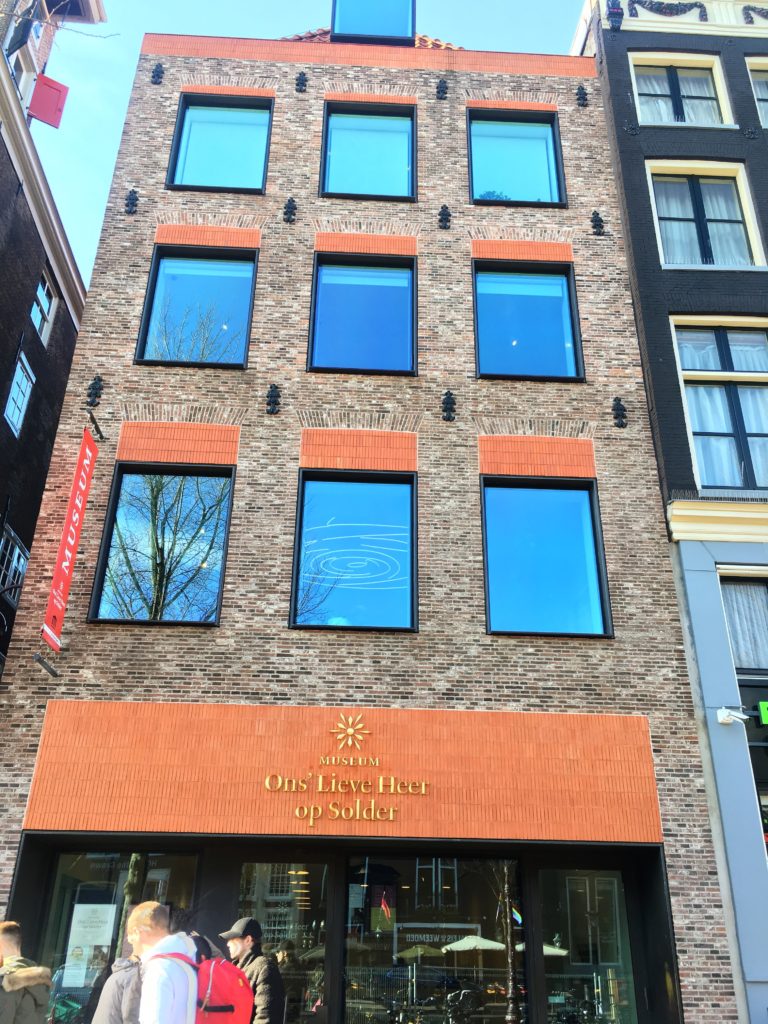
The Netherlands is considered a country of tolerance and diversity since its founding in the 1500s. At that time the Dutch proclaimed the principle of freedom of belief. A fantastic principle in theory, in practice the Dutch said “you are free to believe what you want. However, we support Protestant Christianity, so if you’d like to believe anything else, please hide it from public sight.” Catholics were specifically targeted because the Catholic Spanish that had colonized The Netherlands had just been kicked out of the country.
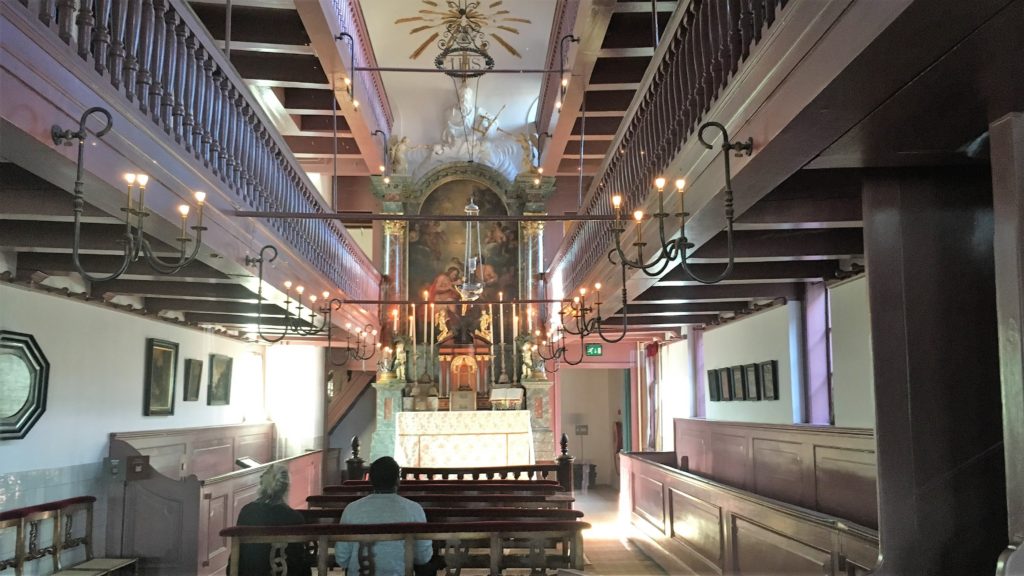
This intolerance led to the creation of churches in the attics of otherwise residential-looking buildings. Our Lord in the Attic Museum is one such church. When you visit, you can see how the residents lived on the first two floors and then enter the church on the third level. The top three levels were cut away to create balconies highlighting the altar and two-story organ in the back of the church. This museum is worth a visit for its unique disposition and place in Dutch history.
Top Outdoor Activities in Amsterdam
Regardless when you visit Amsterdam, plan on spending some time outside. In typical European fashion, al fresco dining is available year-round. Many of the best areas to explore are outside.
8. Canal Cruise

Canals at night from the water
You cannot visit Amsterdam without seeing its canals! Amsterdam is one of seven cities known as the Venice of the North due to its many canals. The best way to experience the canals is from the water itself. Canal cruises are available near the Centraal Station and the Rijksmuseum starting at 10 euros. A canal cruise is also included in your I amsterdam City Card for free! You can choose to spend an hour learning about the history of the city and the canals as your boat meanders through the watery paths around the city, or upgrade your experience with a wine and cheese cruise. I recommend an evening or sunset cruise as the water is even more beautiful with all the city lights reflecting on it.
9. A'DAM Tower
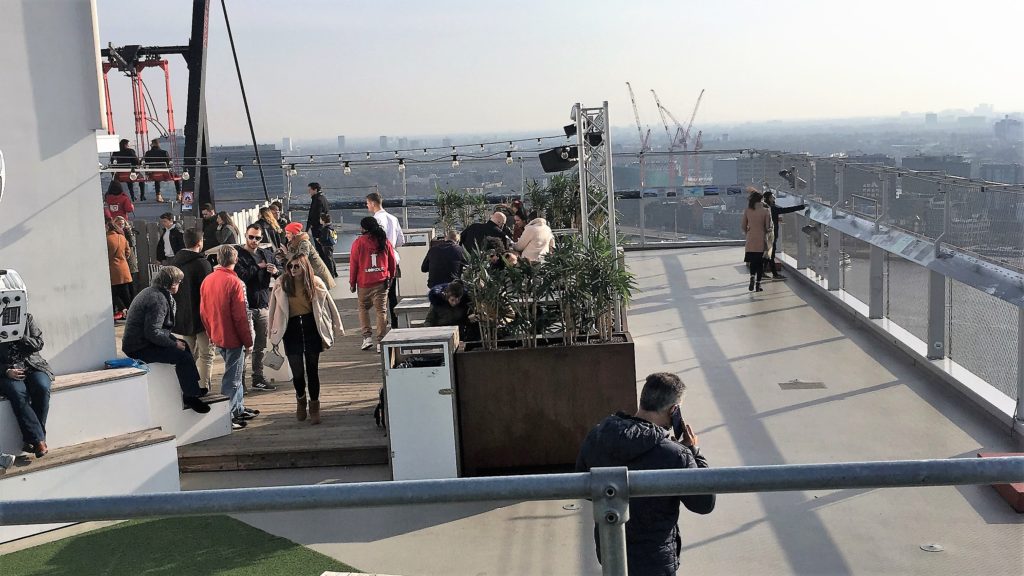
The A’DAM Tower is a new attraction situated across the harbor from the Centraal Station. You can reach it using the free ferry that crosses the harbor every five minutes. The tower itself is a mecca of art and science innovation with many start-ups using office space throughout the building. The top two floors of A’DAM Tower are accessible to visitors. You can eat lunch or dinner in the tower’s dining room while enjoying the views of Amsterdam, or check out one of the rooftop bars. There is one inside the second floor from the top and one actually on the roof. If you are daring, you can take the opportunity to ride on an outdoor swing that sends you over the edge of the tower above the harbor! Whichever option you choose, make sure you spend some time walking around the rooftop for the best views of the city.
10. Dam Square
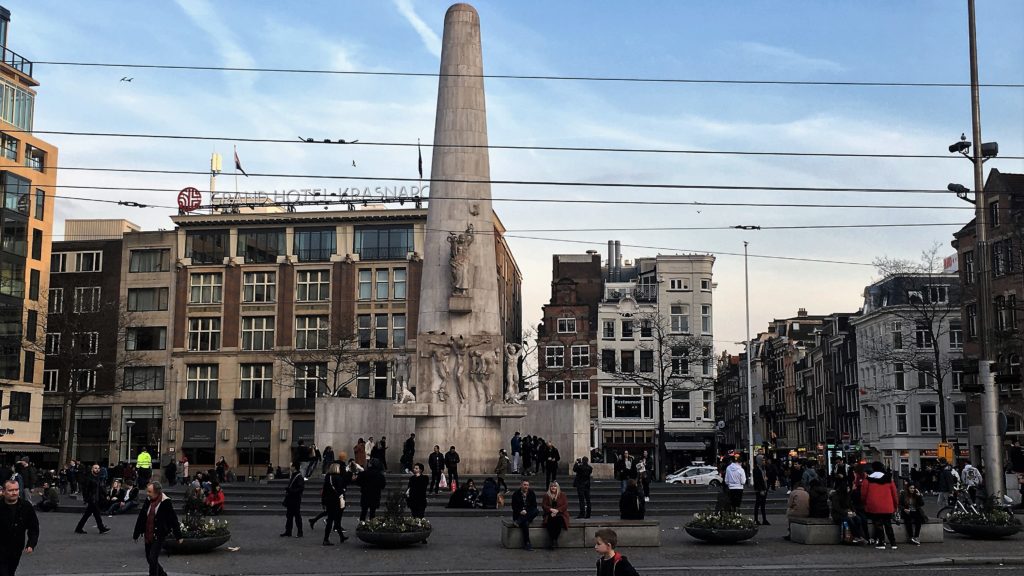
A visit to Amsterdam would not be complete without a walk through Dam Square. This is where you will find Dutch residents relaxing together and tourists watching the street performers pretending to be statues and making giant bubbles.
11. Vondelpark
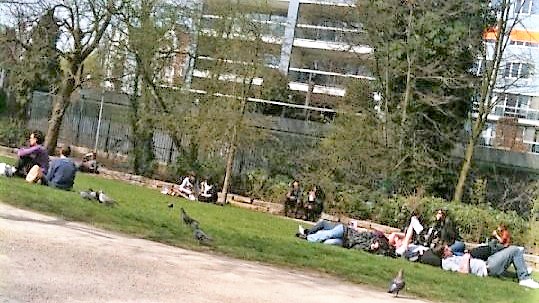
Vondelpark is located outside the canal rings in the Western part of the city. At 120 acres you could spend an entire day getting lost in this park! I especially loved taking morning runs through the park during my first visit to Amsterdam. As you wander through Vondelpark’s tree-lined pedestrian routes you forget that you are in a city where buildings are built almost on top of one another. If you want to escape the city and spend some time in nature during your visit to Amsterdam, head for Vondelpark.
12. Red-Light District
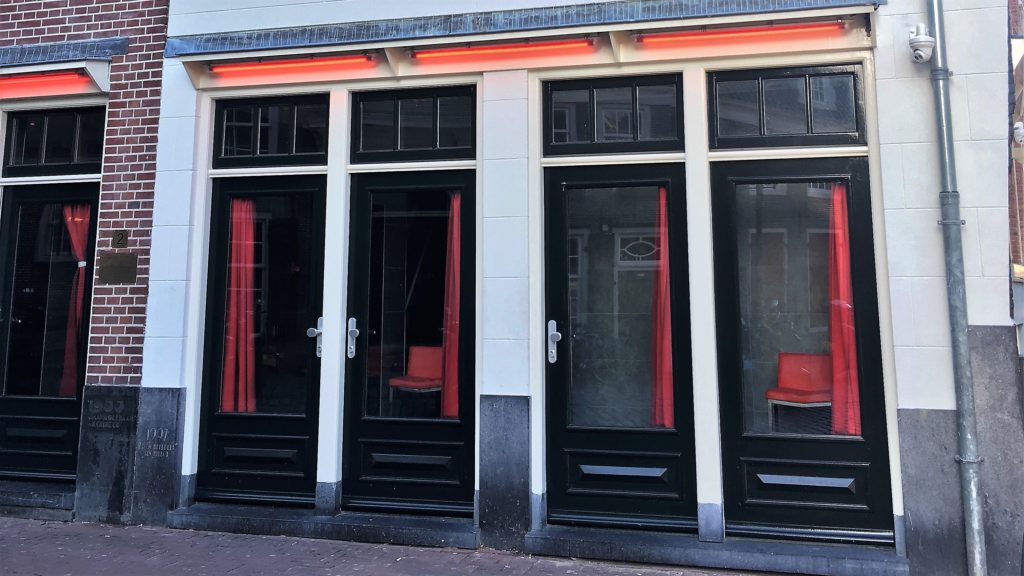
You may be intrigued by stories of the Red-Light District and want to see the area for yourself. You may instead have no interest in the area but might still happen upon it accidentally. The Red-Light District, also called De Wallen, occupies streets in the city center that are also full of cannabis shops, cheese shops, and fry vendors. The women in the windows rent out rooms for an afternoon or evening and then try to entice passersby to join them for a fee.
It is pretty awkward to walk by the windows as the women move seductively and try to make eye contact to catch customers. I did not see anyone take them up on the offer while I was in Amsterdam, and tried to avert my eyes from the buildings in that area. Early in the day there aren’t many windows filled so you can use that opportunity to look inside the rooms through the window if you are curious. Note that you absolutely cannot take pictures of the women in this area, as most of their family and friends do not know they are prostitutes: there are stories that tourists who have tried to do so have had the women come out of their windows and throw the cameras in the canals!
Read more about human trafficking in The Netherlands and how to combat it here: https://ec.europa.eu/anti-trafficking/member-states-0/Netherlands_en.
13. Rembrandtsplein
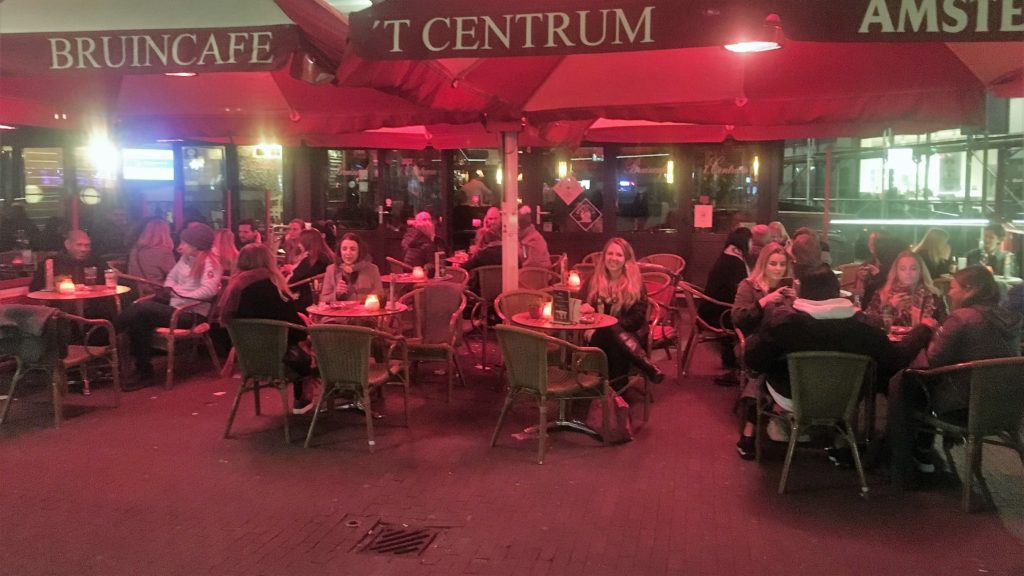
Though many roads in Amsterdam are narrow due to the canals, there are also a few open plazas, throughout the city, called pleins, where residents and tourists alike gather. Rembrandtsplein is one such plaza. The area is pretty chill, attracting a more mature clientele than the nearby Leidseplein. The plaza is surrounded by bars and restaurants open late into the night. This is the perfect place to relax and enjoy a meal or drink outside while watching people wander by after a long day exploring the city.
14. Leidseplein
If Rembrandtsplein sounds too laid back for you, head over to Leidseplein instead. Leidseplein is the plaza with all the young energy. Many students and young travelers take over this area at night participating in pub crawls or looking for a place to dance. As revelers move between establishments, they spend some time in the plaza itself. If you are looking for an exciting night out while in Amsterdam, you definitely want to be in Leidseplein.
15. Shopping in Jordaan or the Nine Streets
You can find typical souvenir shops all over Amsterdam. For more authentic goods, such as real Delft Pottery or maritime antiques, check out the Nine Streets in the Jordaan area of the city. This quiet area is great for wandering around when you want to get away from the excitement of downtown. You can peruse the shops at your leisure and make a few purchases of high-quality items to bring back and remember your trip by.
Find the Best Food and Drink in Amsterdam
16. House of Bols

Everyone has heard of Amsterdam’s Heineken Brewery, but have you considered visiting the House of Bols? Bols Genever has been made in Amsterdam since 1575. It was the precursor to British gin. You probably have seen its unique bottles filled with colorful liquids at your local bar or liquor store. Visit the House of Bols to learn about the history and current production of the genever, then enjoy two cocktails at the bar at the end of your visit. Even if you’re not a gin fan you should still visit the House of Bols: unlike gin, Bols liqueurs come in over 45 flavors and make delicious cocktails for every taste!
17. Pannenkoeken
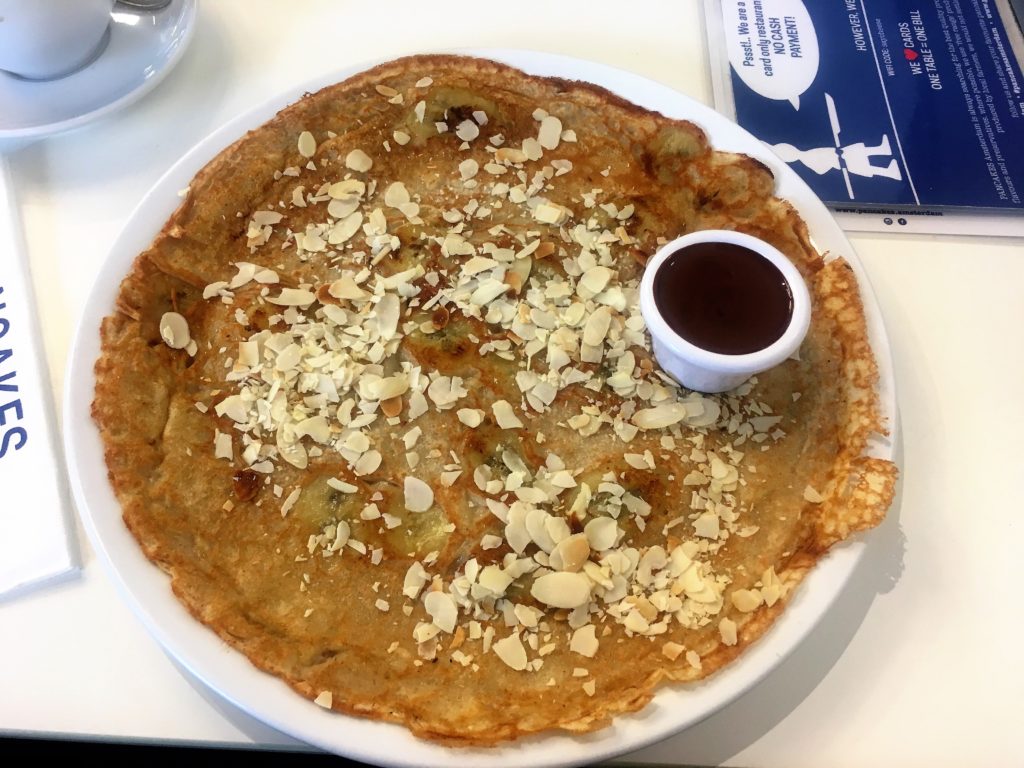
The most traditional Dutch breakfast is the Dutch pancake. A cross between an American pancake and a French crepe, Dutch pancakes are wide and flat with fillings mixed into them. You can try them savory or sweet. I recommend a fruit and Nutella combination. Any pancake house in the city will suffice for trying pannenkoeken, but I am particularly fond of the Carousel Pancake House by the Rijksmuseum.
18. Dinner in De Pijp
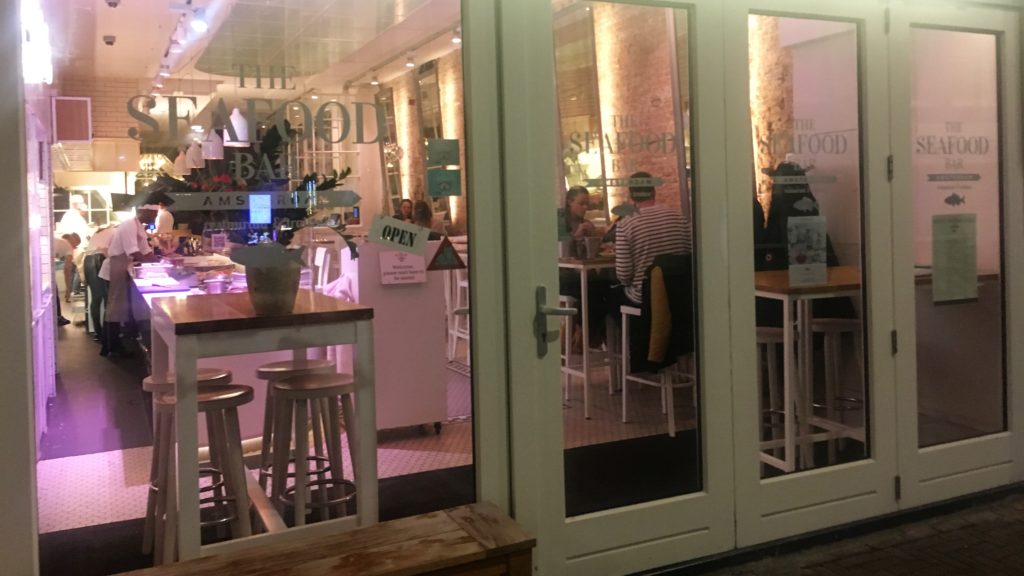
Get away from Amsterdam’s touristy city-center for dinner and pick a restaurant in the trendy De Pijp neighborhood. The restaurants in this area will give you a more authentic experience. They are frequented by locals, not tourists. The atmosphere is very posh and you will get a great meal for your money! The Seafood Bar, in particular, is a beautiful establishment with high-quality seafood where you can take your time eating and enjoying your meal.
19. Coffee or a Drink at a Sidewalk Café
I have a confession: on my first trip to Amsterdam many years ago, I was naive. I thought that you could only buy cannabis at coffee shops. It did not occur to me that you could also get coffee, so I spent three days without caffeine. Last month, I made sure to enjoy at least one cup of coffee per day while in Amsterdam. The best way to enjoy Dutch coffee is sitting at a sidewalk café by a canal. You can order a cappuccino, latte, or espresso inside at the bar and then relax and watch the city’s lively scenery pass by before continuing with your city adventure.
20. Argentinian Steakhouse
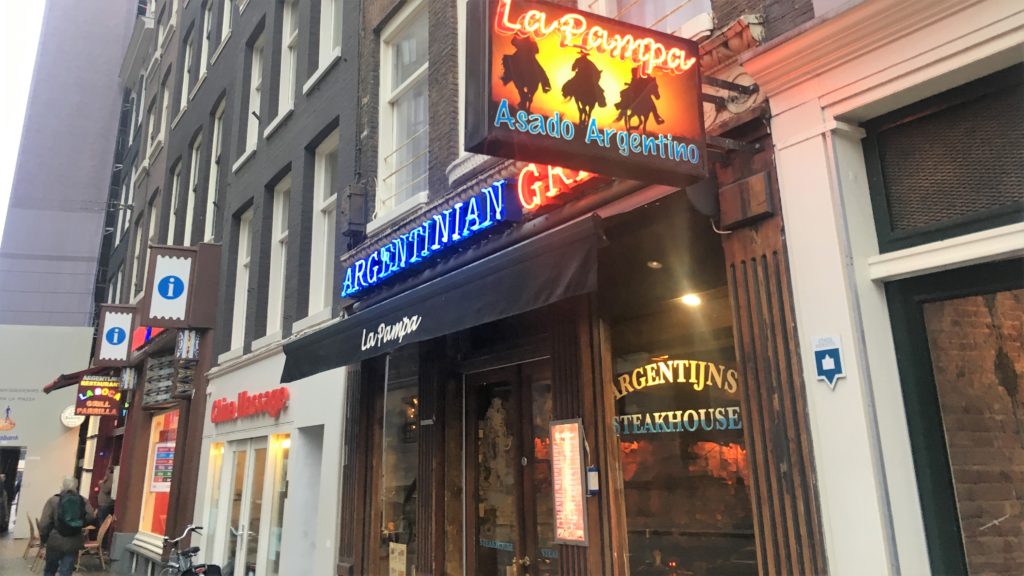
For no apparent reason, Argentinian steakhouses are a big deal in The Netherlands, particularly in Amsterdam! I must have seen at least five on one road, and they were all over the country. The only satisfactory explanation I received was that the Dutch like high-quality meat and steak-and-potatoes is an easy meal to make. This is the most common meal at the steakhouses. Due to the abundance of Argentinian steakhouses in the city, I had to have dinner here one night. It was one of my favorite meals of the trip! The steak was flavorful and perfectly cooked, the salad was light and refreshing, and I couldn’t say no to a glass of Argentinian Malbec wine. It may seem odd to eat South American food while in Europe, but if you’re looking for a great meal, stop by an Argentinian steakhouse in Amsterdam.
Outside the City
Take a Day Trip!
A weekend in Amsterdam is the ideal length. After that, unless you plan on visiting every single museum available on the I amsterdam City Card, you may run out of exciting things to do. Luckily, The Netherlands is a small country with many cities close together. They are all easily accessible with the cheap Dutch train system. Use your time in Amsterdam to take day trips to places like The Hague, Rotterdam, and Zaanse Schans!
Learn more about what to do in these cities here:
A Day in The Hague
Zaanse Schans
Notes on a couple of Amsterdam's top attractions not on this list: Anne Frank House and Heineken Brewery
If you’re wondering why two of Amsterdam’s most famous attractions, the Anne Frank House and the Heineken Brewery, are not on this list, it is not for lack of trying. I failed to visit these places on both of my trips to Amsterdam, and I do not want to recommend places I haven’t seen for myself.
The Anne Frank House used to have visitors stand outside for hours waiting to gain access. The museum has since updated its method for granting tickets. 80% of the tickets available for each day are released online two months in advance. The remaining 20% of tickets are released online at 9 AM the day of the visit. If you plan a trip to Amsterdam less than two months in advance your only option is to try and buy tickets at 9 AM. However, you will need to log on to the ticketing website around 8 AM. I learned this by the last day and was still unable to obtain a ticket before they were sold out. I have heard it is much easier to get tickets two months in advance. If you want to visit the Anne Frank House, be prepared to be diligent in obtaining tickets online!
The Heineken Brewery is easier to gain access to. The only catch is you must show up more than two hours before it closes. On my last day in the city, I noted the brewery closed at 7:30 PM, so I planned to do some shopping and then visit around 6:30 PM. Unfortunately, I needed to arrive by 5:30 PM in order to gain access. I was disappointed I could not visit the brewery and will put it on my list first-thing the next time I am in Amsterdam.
Love this post? Save it to Pinterest for later!
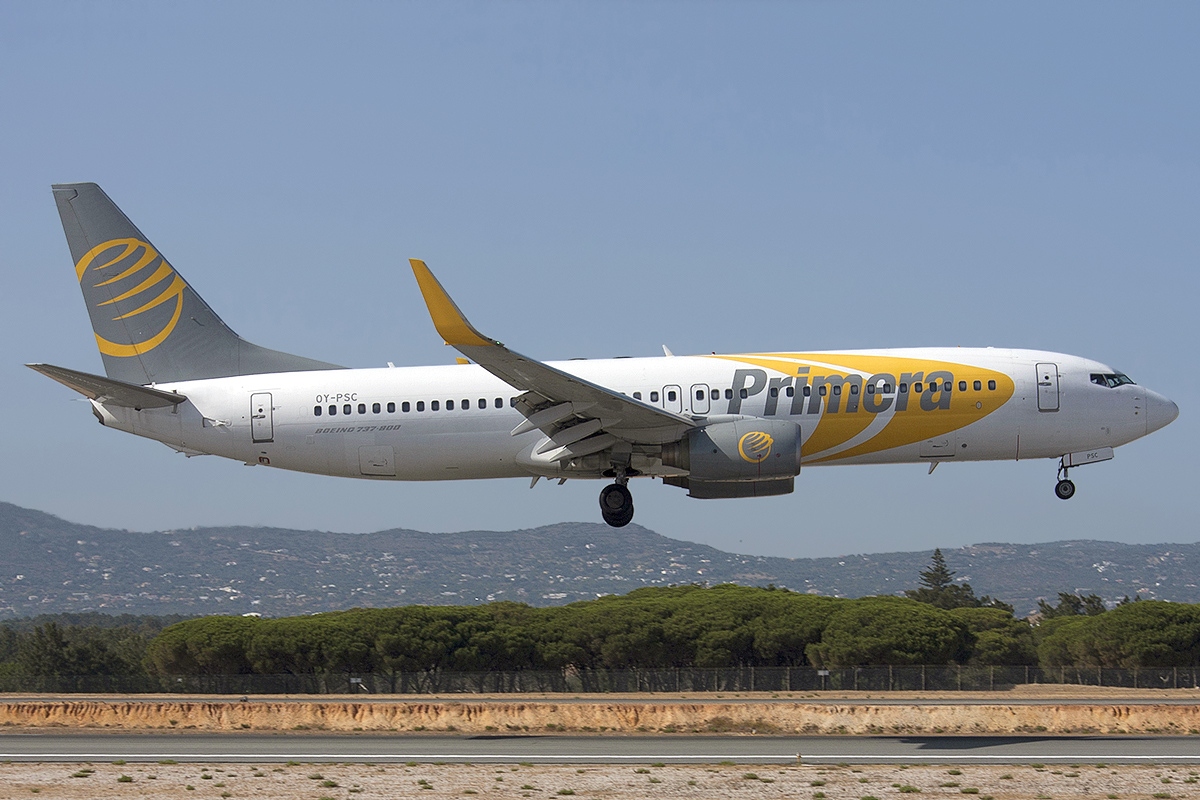
by Kelly | Oct 1, 2018 | Travel, Travel Advice
On October 1, 2018, Primera Air collapsed, stranding all of their customers. They canceled all of their flights and announced they would be filing for bankruptcy. You can find their official statement on their website here.
On October 17, 2018, Cobalt Air suspended all its operations. It canceled all scheduled flights and told customers not to go to the airport.
In 2010, when Iceland’s Eyjafjallajökull Volcano exploded, my parents and I became stranded in Italy. I was living in France at the time, but my parents were visiting me in Europe. This further stranded them in Europe for a week. Classmates of mine were also stranded around the world, from the UK to the Greek Islands to Bogota, Colombia. We all became very savvy travelers very quickly that week.
Based on my experience and lessons learned, I compiled the following list – in no particular order – of things to do to improve your situation if you are stranded by Primera Air. Accomplish whichever you think is best or easiest first. If you have a travel companion or local contacts, tackle multiple items at once.
Consider Alternate Forms of Transportation
Your original intention was to catch a flight to your final destination. If you have a transatlantic flight, this is probably still your best option. However, flights will be packed over the next week or two with every other Primera Air customer. If your original flight path was within Europe, consider taking a train, a ferry, or renting a car.
Trains are the most efficient way to travel within Europe even if there are flights available. If you want to book your trip ahead of time, do so with the local train website in the country you’re leaving from (you can usually only collect tickets from within the country whose website you use).
Alternatively, it is pretty easy to show up at a train station and buy a ticket on-the-spot. If your schedule is flexible or uncertain, this may be the best solution for you.
If you choose to rent a car, ask about local laws regarding taking the car across country borders if your trip will be international. This includes trips within the European Union or European Economic Area.
Look into Alternative Flight Routes
So you had a direct flight back from Paris to Boston this afternoon. Perhaps every other flight from Paris to Boston is booked solid over the next four days, but there are many flights available from London to Boston (they do have five airports compared to Paris’ two). If you find yourself in this situation, consider taking a train or a quick flight from Paris to London to catch a flight from there. This alternative may prove effective in getting you home faster and cheaper than waiting to re-book your original flight path.
Book a Flight
If you must fly to get to your destination, whether using an alternative route or your original flight plan, book a flight ASAP! Remember, there are hundreds of people around the world with flights canceled over the next couple of weeks. They will all be trying to get the same alternative flights you are getting. The BBC reported today that many other airlines are trying to help out Primera Air passengers by offering discounted flights for their remaining seats, but these will sell out quickly. [UPDATE: Norwegian Air released a statement this morning offering to repatriate Primera Air passengers for a 50% discount]. Book your flight now through the normal methods online, and then speak with the airline about any discounts they may be offering to help out.
When my parents were stranded in Europe, they booked themselves a Friday afternoon flight back home. They called the airline later that day but were told there were no flights available until the following Monday. My dad told the airline my parents about the reservation he had made on the Friday flight. The airline allowed my parents to retain that flight for free, as would have been the case for the Monday flight. Alternatively, my friend in Bogota went to the airport every day for over a week trying to catch a standby flight back to Europe. Everyone is going to be trying to find a new flight, so reserve yours now!
Reserve Accommodations
This is fourth on the list because I think it makes more sense to figure out travel plans first. However, if you know you’ll be spending at least one night in your current location, I would make this the first thing you do. My family and I did not do this when we were stuck in Milan with thousands of other travelers. We had to stay in the last hotel with available rooms, which was probably the worst place I’ve ever stayed (including hostels)! Check in with your AirBNB host to see if you can extend your stay given the circumstances, or look online for available hotels in your current city. I recommend a comprehensive hotel search site like Booking.com* for a task like this because it will show you every possible accommodation available.
Notify Your Employer, School, Family, and/or Friends
If you will be missing work, school, or a group vacation, remember to notify the necessary individuals. It may be stressful to tell your boss you need an extra three unscheduled vacation days, or to tell your professor you have to miss tomorrow’s exam because you are in another country, but I found that most people are very understanding in these circumstances. You did not cause the airline to collapse. You did not choose to get stranded and have to find your way home. As my mom’s boss told her in 2010, there is nothing you can do about your situation, so make your best effort to return and otherwise enjoy the extra few days off!
Look Into Other Reimbursements and Discounts
The extra flight and accommodation costs will unfortunately not be your only additional expenses. Maybe your vacation is now canceled or delayed, but you have a hotel booked for the next week. Maybe you parked your car at the airport and now suddenly will have to pay for an extra three days. Like the people in your life, most companies are understanding in these circumstances and will give you a discount or full reimbursement. This is especially true with hotels that can re-fill the room in which you were supposed to stay. You may even be helping out a fellow stranded passenger by freeing up a hotel room!
Relax and Enjoy your Extra Time
Once you have completed the above steps, take advantage of your extra vacation days! The stressful part is over. You have additional, unexpected days of vacation. Did you try to cram everything you wanted to do into a few short days? Maybe now is the time to pick your favorite attraction and go spend some extra time really getting to know it. If you’ve already seen everything you hoped for in your destination city, this could be the time to try something off the beaten path or spend time living like a local (if you want to try this in Northern Wales, check out my local recommendations in this post). Make the most of the additional time you now have, knowing that everything is in place for your delayed return.
Recovery from Primera Air
After you have safely reached your destination, you may consider pursuing claims against Primera Air for recovery of any travel expenses or losses. The aforementioned BBC article noted that it is unlikely most passengers will be able to recover anything from the airline because of the bankruptcy filing, but offers alternative avenues to pursue like those with the credit card companies. If you are an American citizen or have a flight involving the States, you may have American remedies available to you. You should contact an attorney if you choose to pursue a legal remedy. Bankruptcy law can be tricky and most customers are the last people to get paid in such instances after most of the money has run out.
Good luck to everyone stranded out there, and safe travels home!
Looking for more travel advice? Check out these other related posts!
*Note, this page contains affiliate links. This means I may receive some compensation for your use of the link at no extra cost to you.





























































